TIMELESS INSPIRATION


81 ISSUE
Sharing his timeless watch style with Omega CHEF MONICA GALETTI | BRITISH LUXURY REVIEW | THE FUTURE OF YACHTING DANIEL CRAIG


 * Piper-Heidsieck Chief winemaker was acknowledged as best of the year nine times since 2000 by the IWC.
* Piper-Heidsieck Chief winemaker was acknowledged as best of the year nine times since 2000 by the IWC.
PIPER-HEIDSIECK PAVES A NEW WAY IN CHAMPAGNE BY ACHIEVING THE B CORP SOCIAL AND ENVIRONMENTAL CERTIFICATION.


PROTECTING EVERYTHING AND EVERYONE YOU HOLD DEAR
INVESTIGATIONS & SURVEILLANCE


TECHNICAL SURVEILLANCE COUNTER MEASURES (TSCM)

FULL SECURITY AUDITS PENETRATION TESTING
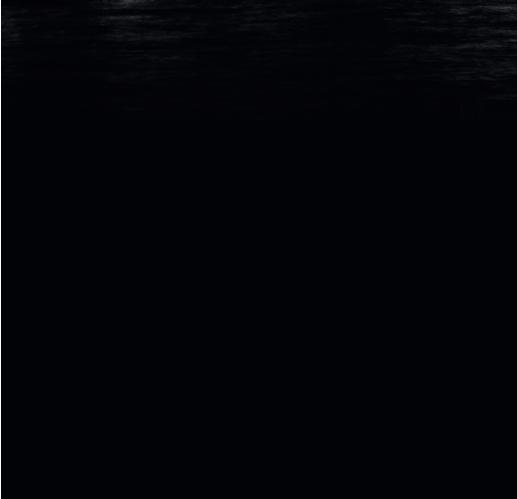
Valkyrie is a specialist security organisation drawing on over 100 years of combined experience in Britain’s most elite military and intelligence units. We protect you, your families, homes and businesses by delivering high-level cyber and physical security solutions, tailored to your individual needs. Whether you are looking for a discreet and comprehensive way to safeguard your family’s interests, or you are a UK or international business looking to mitigate security risks, we are committed to building long-term, trusted relationships that you can rely on.
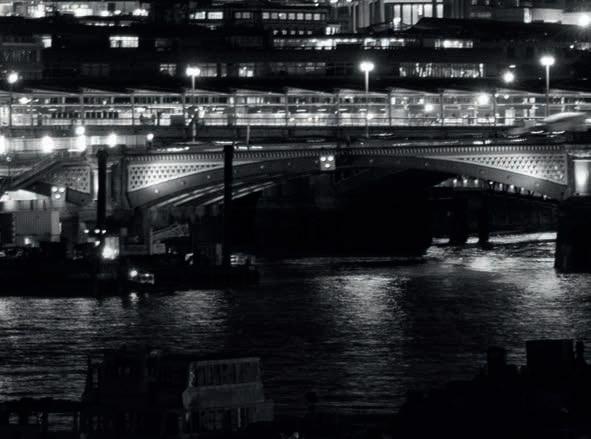




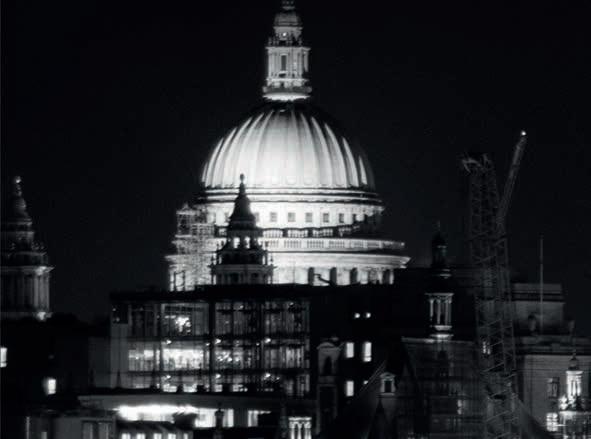

















+44 (0) 20 7499 9323 security@valkyrie.co.uk www.valkyrie.co.uk
A taste of things to come
“There’s magic in how we come together around a table,” says author Christina Makris. I met the author for breakfast at Mayfair’s Langan’s Brasserie to discuss her book, Aesthetic Dining: The Art Restaurant Around the World, and learn about her philosophical take on what she’s describes as the theatre of fine dining.
It was the first time we’d met but, as we sipped smoothies and enjoyed classic poached eggs among the restaurant’s beautifully curated gallery walls, it was more like conversing with a friend. Langan’s famous art collection includes pieces from numerous museums, galleries and charities –including Tate London, Art for Black Lives and the Terrence Higgins Trust – curated by Sophie Oppenheimer. The result is a bright, convivial décor that is both inviting and energising: and serves to prove Christina absolutely right.
The rituals of breaking bread and sharing a meal in such a stylish atmosphere had worked their magic, leaving us free to jump from the topics of art and food – the reason we were there – to travel and music, goals and interests, and even to touch on the eccentricities of modern politics.
At this time of year, the art of eating out can be both amplified and exhausting. With those of us in the UK
enjoying our first restriction-free festive season since 2019, the party invitations are rolling in thick and fast, leaving us to balance the rush of a packed schedule with the lure of late nights celebrating with friends and family.
Thankfully, the best venues will only add more festive spice to our celebrations, helping us slow down and appreciate just how fortunate we are to be packed around a table sharing fine food and wine with our loved ones once again. And to celebrate that fortune, this issue, Christina shares the most beautiful dining destinations in the world (16), we explore London’s thriving music scene (70), update your party wardrobe in Rikesh’s lastest style column (112), and gather the very best gifts of the season in our festive Luxe List (10).
Elsewhere in the issue, Daniel Craig reflects on his partnership with Omega (36) and Chef Monica Galetti –founder of Mere, London, and MasterChef: The Professionals judge – leads our celebration of women super-chefs (66).
On behalf of all the team at Tempus, I wish you a very happy and prosperous new year.

Enjoy the issue
Michelle Johnson Editor


© 2022 Vantage Media Limited

Articles and other contributions published in this journal may be reproduced only with special permission from the Publishers. The Publishers, Vantage Media Limited, accept no responsibility for any views or statements made in the articles and other contributions reproduced from any other source. No responsibility is accepted for the claims in advertisements appearing in this journal and the Publishers reserve the right to accept or refuse advertisements at their discretion.
Share your thoughts by contacting us via email at info@tempusmagazine.co.uk, or visit tempusmagazine.co.uk for your daily update from the world of luxury lifestyle
6
Tempus Magazine is published by Vantage Media Limited. www.vantagemediagroup.co.uk
“THERE’S MAGIC IN HOW WE COME TOGETHER AROUND A TABLE”
Contributors
Editorial team
Editor
Michelle Johnson michelle@tempusmagazine.co.uk
Creative Director Ross Forbes ross@tempusmagazine.co.uk
Rikesh Chauhan
Menswear maestro Rikesh has got your winter wardrobe sorted with his pick of perfect party pieces (112)

Digital Editor Gabriel Power gabriel@tempusmagazine.co.uk
Wealth Editor Lysanne Currie

Motoring Editor Rory FH Smith
Judy Cogan
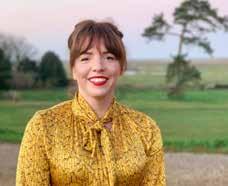
From Monaco to MasterChef, Judy uncovers next year’s most vital trends from the worlds of yachting (52) and fine dining (66)
Chief Sub-Editor Dominique Dinse
COMMERCIAL
Sales & Partnership Enquiries info@tempusmagazine.co.uk +44 (0) 203 519 1005
VANTAGE MEDIA
Matt Leek
Does rugby need to change? Player turned manager Matt makes his case for a more mindful, holistic sport (30)

Chairman Floyd Woodrow Managing Director Peter Malmstrom
COVER IMAGE

Christina Makris
Aesthetic Dining author Christina shares her pick of the world’s most important art restaurants on page 16
Daniel Craig wears the Omega Seamaster Diver 300m “60 Years of James Bond”. © Courtesy of OMEGA Article on page: 36
Responsibly printed
Printed by Cambrian Printers, UK on GalerieArt Matt Woodfree FSC Mix (FSC® certified paper) using vegetable inks and sustainable printing methods. www.cambrian-printers.co.uk
Tempus Magazine 25 Wilton Road London SW1V 1LW
tempusmagazine.co.uk info@tempusmagazine.co.uk +44 (0) 203 519 1005
@tempusmagazine
@tempusmagazine
7
The luxe list Our festive pick of the most exciting launches and must-have gifts of the season
Feast your eyes Author Christina Makris recommends the most beautiful art restaurants in the world
Beyond Champagne How Piper-Heidsieck became the first champagne house to achieve B Corporation Certificatio
The spark of life Genesis is the luxury car marque bringing Korean hospitality to the world of high performance EVs
Transforming the game Parmenion Sports Management founder Matt Leek on why professional rugby must change
Ocean tracks We test Iguana Yachts’ amphibious solution to high tech seafaring
A cinematic partnership Actor Daniel Craig reveals his timeless style as Omega celebrates 60 years of James Bond
Time will tell Take a closer look at the GPHG prize-winning Parmigiani Fleurier Tonda PF 36mm
Symbols of change The incredible icons and philosophical focus of Ukrainian artist Andrey Laponov

Bahamian vision How Baha Mar is launching island art and design to an international stage
Setting sail We take a look at the new trends making waves for the future of superyachts
Living rooms Interior designer Manuela Hamilford on blending contemporary cool with classic architecture
Old world, new world Legendary Australian winemaker Penfolds breaks new ground in Bordeaux
Recipe for success Meet the female superchefs are making their mark on the British restaurant scene

City of music Discover the best London venues raising the bar for the capital’s thriving music landscape

The British Luxury Review Tempus examines the state of UK luxury and predicts what’s in store for 2023
Island jewel Experience barefoot luxury in serious style at the Bulgari Hotel Bali
Ocean drive We put Bentley’s new extra long Bentayga through it paces along America’s Pacific Coast
Past, present and future Vacheron Constantin’s Christian Selmoni on the importance of heritage
Best of British Celebrating UK brands at the Walpole British Luxury Awards
Reshaping capitalism Paul Lindley OBE leads a growing number of HNWs calling for change
A climate of chaos After the Cop27 climate summit in Sharm el-Sheikh, the world asks: have we done enough?
RE:VIEW Pictorum Gallery presents its first exhibition, plus our pick of must-visit restaurants, shows and events
Save the date The finest events of the season
Winter formal Our style columnist Rikesh Chauhan on dressing to impress this festive season
81
CONTENTS 10
16
22
26
30
32
36
40
42
48
52
58
64
66
70
74
78
84
88
92
95
100
103
108
112

36 A cinematic partnership
The LUXE LIST
A festive edition of our essential guide to the most exciting new launches and seasonal gifts

Penfolds Grange Record Player Console
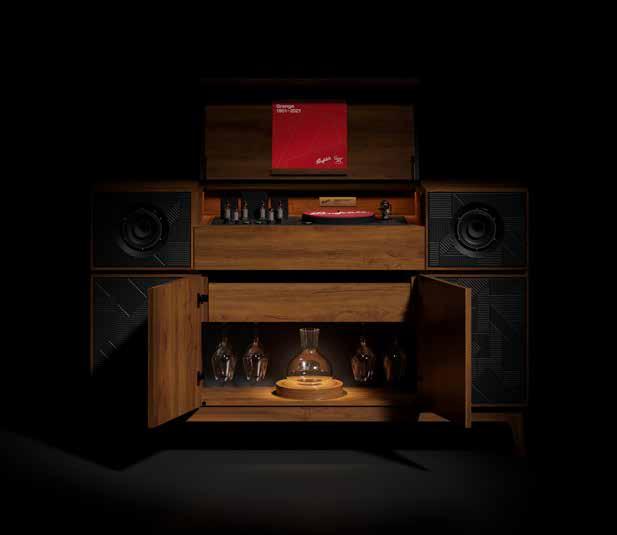
If you’re a fan of vintage wine, vinyl records, and 1950s inspired interiors, this limited-edition record console (right) created by heritage Australian winemaker, Penfolds, is the ideal gift. Celebrating the 70th anniversary of Penfolds’ flagship blend, Grange, the piece is available exclusively at Harrods, priced at £55,000 – and one of just seven made. Not only does this record player offer up an extraordinary sound system, it doubles as an integrated wine bar with a hand blown Grange Decanter, eight Riedel Extreme Shiraz glasses and –best of all – a Grange magnum duo from 2010 and 2017. Find out more about Penfolds on page 64.
penfolds.com
3Bomber x Bentley Bentley Motors has teamed up with Bomber Ski to create a new collection with speed, performance and elegance in mind. Each set of Bomber x Bentley ICE Edition skis (left), limited to 200 pairs, take 32 hours to create and are suitable for multiple terrains. Matching accessories are available, including ultra-lightweight carbon and aluminium ski poles, and a Bomber x Bentley helmet designed for style and safety, featuring innovative materials and a removable fragrance release system by Oikos fragrances for added freshness on or off piste.
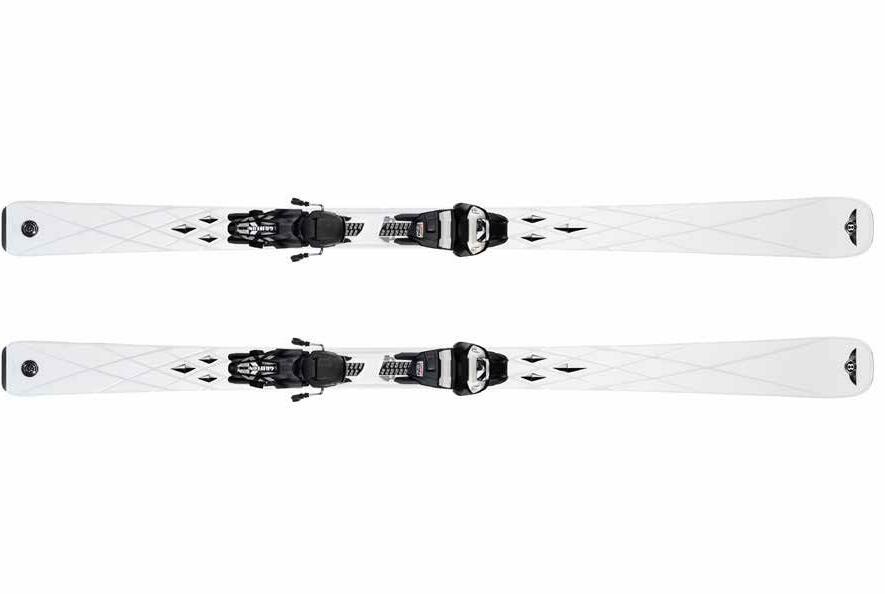
bomberski.com
1Breitling Premier Tourbillon
This trio of three chronographs, inspired by the line first introduced by Breitling’s founders in the 1940s, features precious metals and a tourbillon. The Premier B21 Chronograph Tourbillon 42 comes in three expressions, each inspired and named for founders Willy, Léon and Gaston. The Léon Breitling (left) features a solid 18k red gold case with a silver dial; the Gaston Breitling pairs a solid 18k white gold case with an anthracite dial; and the Willy Breitling comes in solid platinum with an admiral blue dial. Each is finished with an alligator strap. A stylish return for the brand’s founders’ squad… breitling.com
Velvet at Corinthia London

Legendary bartender Salvatore Calabrese has opened the doors of his opulent new cocktail bar, Velvet (right), at London’s five-star Corinthia. The bar, which aims to bring back the ‘theatre’ of cocktail creation, features a series of Salvatore’s best-known creations, including the Breakfast Martini and Spicy Fifty – and will redefine the Roaring ‘20s for the modern day in style. »
corinthia.com
11 2
4
The Rock Hound
With big name fans such as Mission Impossible star Hayley Atwell, The Rock Hound is an ethical jewellery brand to watch. The British jeweller is known for combining responsibly sourced raw materials and bold gems with striking, playful design. From geometric earrings (left) to colourful cocktail rings, these gems exude attitude. A statement gift that truly rocks.

therockhound.com
6Space Perspective
If you’re searching for a gift for the person who has everything, the world’s first luxury and zero-emissions spaceflight company might have the answer. Space Perspective is offering adventure seekers the chance to journey to the edge of space for a market-beating price of $125,000. The six-hour Spaceship Neptune voyage comes complete with reclining seats and 360-degree viewing windows, onboard WiFi and a bar. Ready for launch from 2024, this gift is truly out of this world…

spaceperspective.com

5
Hennessy Hands
Exclusive to Harrods, Hennessy Hands’ personalisation service allows for laser-engraved inscriptions to adorn the already sculptural bottle of Hennessy Paradis (left), as well as a customisable leather clip by French leather specialists, Tanneries Roux. Available in an array of bespoke and handcrafted options and colours – from Harrods green to embossed gold or silver – with all options added to the Hennessy Paradis bottle in the boutique.
hennessy.com
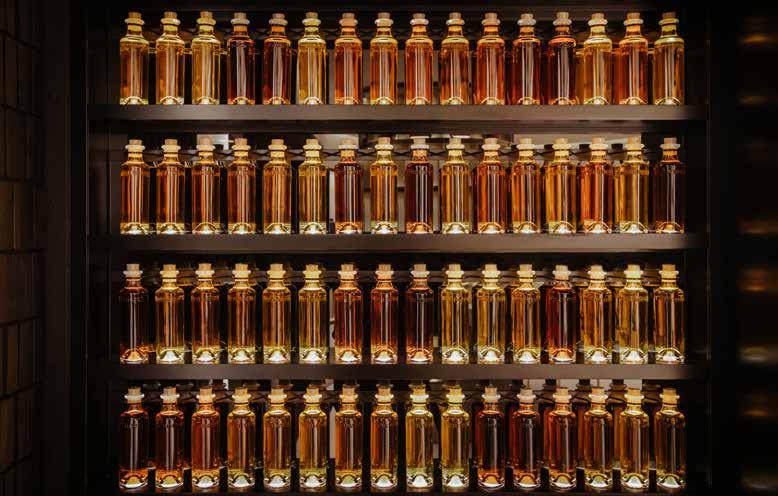
8Cashmere Lofty Blanket Scarf by Loop
This lofty blanket scarf from Loop Cashmere does everything; you can cocoon yourself against the cold mornings, drape it as a blanket while lounging and layer up to travel in style. Soft, fluffy, and generously sized, this sustainable scarf (right) makes dressing for even the coldest weather an enjoyable affair. The scarf is available in a range of colours including whisper blue, ballet pink, foggy grey and khaki green, with a lofty knit adding warmth without bulk for the softest way to stay warm.

loopcashmere.co.uk
James Turrell & Lalique
The first collaboration between Lalique and American artist James Turrell sees the haute crystal maker release a series of 42 crystal light panels and two perfume bottles, each in a limited edition of 100, first presented at Paris+ par Art Basel this year. The shining result of a four-year collaboration, James’ pieces celebrate Lalique’s 100-year anniversary with a collection that celebrates light and space. The two perfume flacons – Range Rider and Purple Sage (left) – are handmade crystal prisms that diffuse and diffract the light. James also co-created the two perfumes, using scents from his native Arizona to capture the beauty of the American West. »
lalique.com

13
7 9
Pico 4 VR Headset

Leading VR brand Pico has launched the Pico 4 (left), a nextgeneration, all-in-one VR headset that aims to make VR accessible to everyone by combining comfort and performance. Equipped with a Qualcomm Snapdragon XR2 chipset, the Pico 4 features a super lightweight body, Pancake Optics, 4K+ resolution display, and an intuitive user experience. Pioneering the next generation of VR hardware design, Pico’s new headset makes the
The Impossible Collection of Champagne
Discover the 100 most exceptional bottles from Champagne in a book curated by World’s Best Sommelier Enrico Bernardo. The Impossible Collection of Champagne pops the cork on three centuries of champagne-making, taking readers from unique vintages to modern masterpieces. Presented in an exceptionally crafted wooden box, the 236-page edition is bound by hand and luxuriously crafted with hand-tipped labels. Available at Piccadilly’s Maison Assouline, it’s the perfect collector’s piece for champagnelovers. Cheers!

maisonassouline.com
Noble
Isle Fireside Botanical Candle

Best known for its range of scented bath and shower products, Noble Isle’s stunning new seasonal candle (right) enchants all the senses. A visual delight –with embedded slices of dried orange, pink peppercorns, star anise and cinnamon sticks – the fragrance is warm and woody with classic winter spices of ginger, black pepper, vanilla and cinnamon, and a zesty grapefruit top. A scentsational candle for the festive season.
nobleisle.com
10
12
11
Frederique Constant Classics Carrée Automatic

Evoking the spirit of the Roaring 20s, these three new variations of Frederique Constant’s Classics Carrée Automatic come in rose gold-plated or steel with white dial, and steel with blue dial (right). The attractive minimalist style includes baton indexes, dauphine hands and date, and subtle guilloché pattern on
Enielle
Natural Swiss skincare brand Enielle is on a mission to fight Skin Cell Senescence – the loss of a cell’s power of division and growth – through a luxurious and indulgent army of products from serums (right) to creams. The Antidote No 1’s key ingredient is taken from natural sources such as the red kidney bean, and designed to regenerate the skin to promise a smooth complexion without wrinkles, blemishes and age spots. A delightful antidote.

enielle.com
Mortlach Midnight Malt 30-Year-Old

The new Mortlach Midnight Malt 30-Year-Old (left) makes for an ideal gift for the whisky connoisseur or the limited-edition enthusiast. Aged 30 years, this is the boldest, deepest and most intriguing expression of Mortlach malts. Distilled 2.81 times, this unique spirit was initially matured in a combination of refill American Oak and European Oak casks, split to finish in Bordeaux wine, Calvados and Guatemalan rum seasoned casks, then finally married in custom quarter casks.
mortlach.com

15
13 14 15
FEAST YOUR EYES
Something very special happens when fine art and fine dining combine, according to Christina Makris, author of Aesthetic Dining: The Art Restaurant Around the World. Discover Christina’s top destinations for indulging the senses as she shares her philosophy


16
Each summer, I have a birthday tradition to visit the Colombe d’Or in the south of France. Usually we sit outside, where we can people watch over a long lunch; but, one year, there was a storm and we were rushed inside the restaurant with military precision.
We found ourselves dining surrounded by the Colombe d’Or’s world-famous art collection – taking in works by Picasso, Miro, Matisse – and it was incredible to be able to be able to view the art in such an intimate, slow way, while enjoying our lunch. That’s when the idea for Aesthetic Dining was born.
I come from a family of restaurateurs, but my academic background was in philosophy before I moved into finance. I’m also an art collector and patron of the arts, so was writing articles about art, design, food and wine, and
how these elements come together. I started researching other restaurants frequented by artists, or that housed art collections.
Over the next four years, I travelled the world – from France, Italy and Egypt to America and Australia – to find venues and chefs with a strong association with the arts or artists. As I got to know different places, I found many stories of friendships between chef and artist. There’s a real affinity between the two vocations that’s very complimentary; an interest and respect for each other’s process. After all, there’s an art to the rhythm of a restaurant, from preparing dishes to seeing the transition from lunch to dinner –it’s like theatre.
There are rituals in breaking bread around a table, opening a bottle of wine, that I think
are quite important. Something about being around the table and dining with friends – whether it’s ad hoc or a grand occasion – is eternal. There’s magic in how we come together, and my philosophy is that the right environment can enhance our ability to think and eat together.
A great dining experience must combine food, surroundings and company; an authentic atmosphere contributes to the memories we make together. And, when you place beautiful art into the mix, it takes the experience to the next level. Read on to discover some of the most beautiful art restaurants in the world... »
‘Aesthetic Dining: The Art Restaurant Around the World’ is published by Cultureshock christinamakris.com

17 FINE DINING
CHINA CLUB | HONG KONG
The late entrepreneur and art collector, Sir David Tang, established private members club and restaurant, China Club, in his native Hong Kong in 1991. The club displays a substantial portion of Tang s art collection. The collection, featuring more than 500 pieces, is a survey of modern and contemporary Chinese art. This art restaurant is a synthesis of opulent yet understated interiors and high-quality cooking, with every hallway and staircase filled with artworks from the multifaceted traditions of Chinese art.


laisundining.com

18
COLOMBE D’OR | PROVENCE, FRANCE

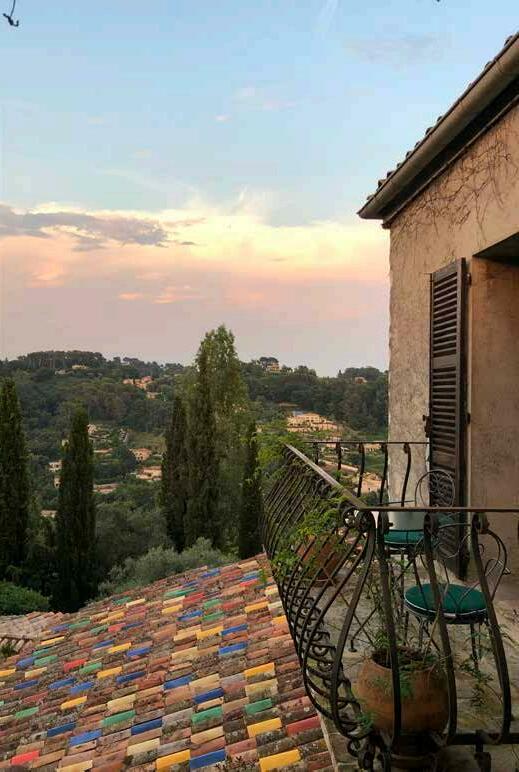
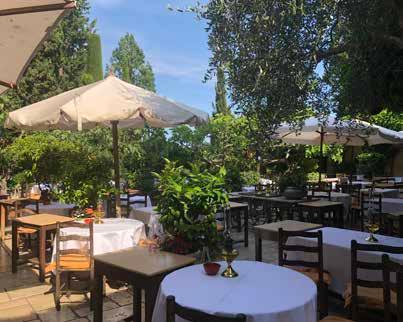
A haven for artists and tastemakers for over a century, the Colombe d’Or has played host to some of the greatest names of modern European art, such as Picasso and Matisse, Calder and Miró. The Colombe d’Or is often cited as an inspiration and the perfect restaurant experience for many restaurateurs – and it’s a timeless space that keeps its diners captivated and existing on a different sense of time, as though they are in one of its achievable black and white photos from a time past.

CASTELLO DI AMA | TUSCANY, ITALY
A tiny medieval borgo situated between Siena and Florence, nestled in the heart of Chianti, Castello di Ama has been producing wine, its “nectar of the land” for four generations. The recent addition of the contemporary art and restaurant on the estate attracted a new audience of collectors and gourmands. At Castello di Ama, art, wine and food form a synergy for exploring taste, the “mission of life”, according to its owner, Lorena Sebasti. »

castellodiama.com
 la-colombe-dor.com
la-colombe-dor.com
THE GUNTON ARMS | NORFOLK, UK

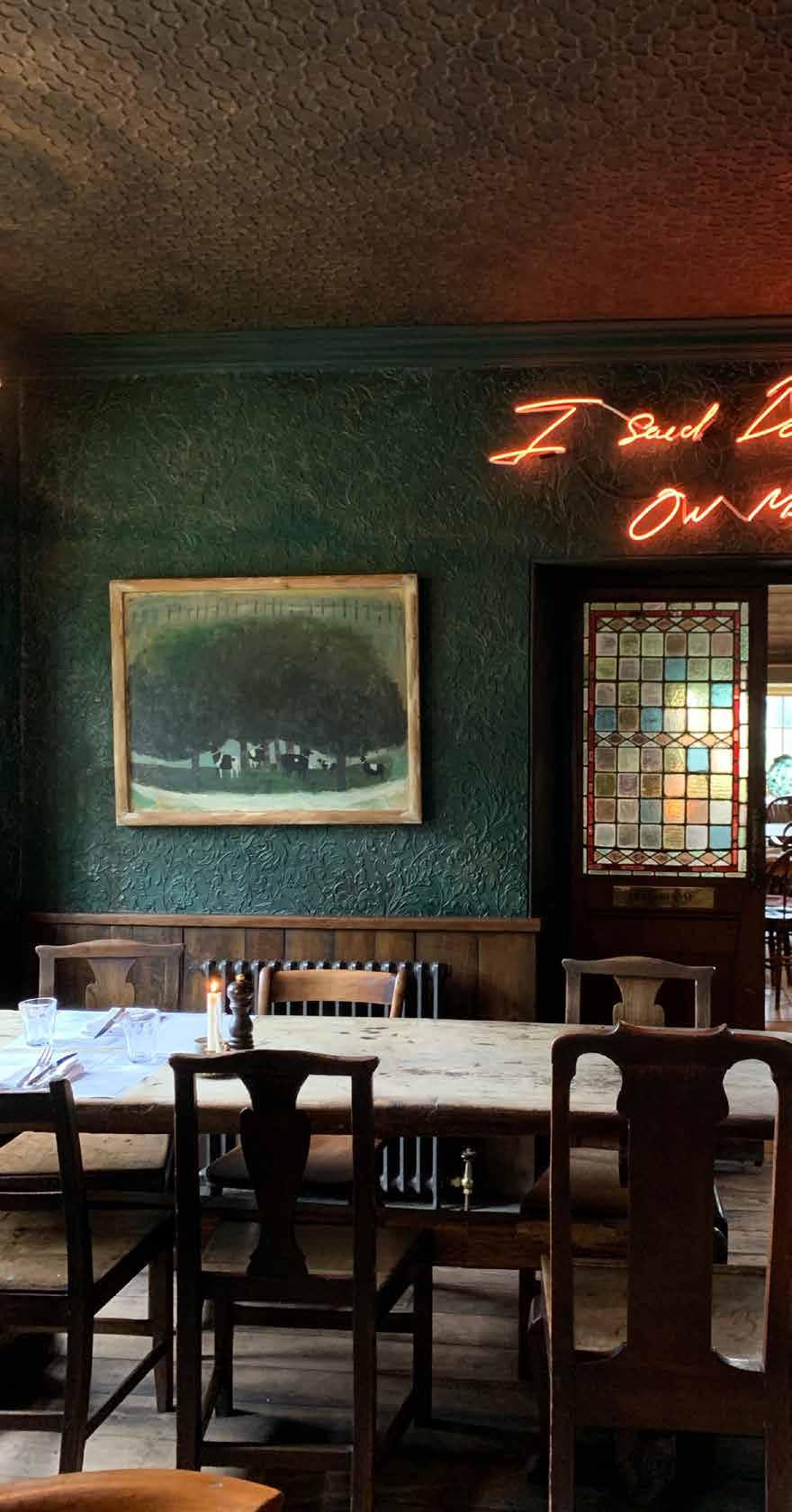
The Gunton Arms is a 19th century former shooting lodge in Gunton Hall Park, owned by the Suffield family. The Norfolk pub, owned by art collector turned restauranteur, Ivor Braka, dishes out rural, Edwardian fantasy, alongside traditional rustic British fare. The art collection is the proprietor’s personal collection, which includes global names, such as Tracey Emin, Paula Rego, Tom of Finland, and are integrated as part of Braka’s thesis on Gunton being a haven for the irreverent.
theguntonarms.co.uk
MICHAEL’S | SANTA MONICA, US
Michael McCarty is the man who invented the modern restaurant in America in the 1980s, by breaking formal European traditions and inserting his version of all-American dining. By creating his eponymous restaurant in Santa Monica in 1979, fine dining would now take place in a relaxed way, with modern art around the table. Central to McCarty’s vision of what a restaurant should be was displaying art, which he collected for decades, rotating works between home and his restaurants’ walls, the two being interchangeable for him.



michaelssantamonica.com

21
FINE DINING
IMAGES: GUNTON ARMS. COLOMBE D'OR. CASTELLO DI AMA. CHRISTINA MAKRIS/CULTURESHOCK
BEYOND CHAMPAGNE
As Piper-Heidsieck becomes the first champagne house to achieve B Corporation Certification, Tempus learns how the brand is uncorking a sustainable future beyond the vineyards

Founded in 1785, Piper-Heidsieck is one of the Champagne region’s boldest and most auspicious maisons. With one bottle popped every six seconds, the brand is the most highly awarded champagne house, known for its consistent and iconic cuvées.
With such a long and storied history, there's little doubt that Piper-Heidsieck could focus on tradition alone to continue its success; instead, its enthusiasm for winemaking excellence has seen the brand make constant innovations –
such as hiring one of the region’s youngest chief winemakers, Émilien Boutillat, in 2018. Émilien’s innovative state of mind has now seen PiperHeidsieck become the first champagne house to certified as a B Corporation, aiming to continue to improve the quality of its wines while having a proactive, positive social and environmental impact through sustainable practices.
B Corp certification is given to businesses that meet high standards of social and environmental impact, verifying its performance, accountability
and transparency by allowing information to be measured against B Lab’s criteria. Non-profit network B Lab scores businesses on these areas with a total of 80 points required to be certified –Piper-Heidsieck obtained 91.9 points.
“Achieving B Corp certification reflects our pioneering ethos and daring initiative to be a driving force of change in the champagne industry,” said Piper-Heidsieck CEO Benoît Collard. “This certification not only recognises our environmental impact in the vineyards, »

Tradition and innovation: Piper-Heidsieck is merging heritage craft and new technologies to create a sustainable future for Champagne but extends to our entire winemaking ecosystem, our community and our workplace.”

Benoît explains that the brand’s future aims cover a variety of areas, including carbon footprint reduction, supply, Piper Lab and social impact. This covers practical goals from minimising the house’s carbon footprint by 46% per bottle by 2030 and having the lightest bottle on the market, to launching a drastic energysaving programme in addition to the brand’s switch to 100% renewable electricity in 2021, and investing in organisations like Time for the Planet and the International Wineries for Climate Action to help tackle climate change.
In the social arena, Piper-Heidsieck has pledged to endorse gender equality and parity for managers – 51% of whom are currently women – and advocating for inclusion by engaging with young, emerging and diverse talent in both its employees and collaborations across all campaigns.
Piper-Heidsieck’s most innovative sustainable practices will no doubt emerge from the brand’s Piper Lab, which is devoted to preserving and
enhancing biodiversity and local species – from implementing viticultural experiments in cover crops, organic farming and agroforestry to planting 1000 trees and shrubs and installing eight beehives to preserve and promote biodiversity in its vineyards.
“This process began with an innovative vision from our chief winemaker, Émilien Boutillat, which propelled our entire team on a journey to work together towards a shared mission, and I am immensely proud to see this remarkable achievement brought to life,” said Benoît. “Becoming B Corp Certified marks a commemorative occasion in the history of PiperHeidsieck, yet it also signifies that together, we are striving towards sustainable change and we hope to inspire others in the wine industry to implement similar initiatives.”
For Benoît and Émilien, the move to innovate is natural one, inspired by Piper-Heidsieck’s past. The grand marque has its roots in the champagne first created by German winemaker Florens-Louis Heidsieck in 1777. By 1785, his maison, Heidsieck & Cie, boasted Marie
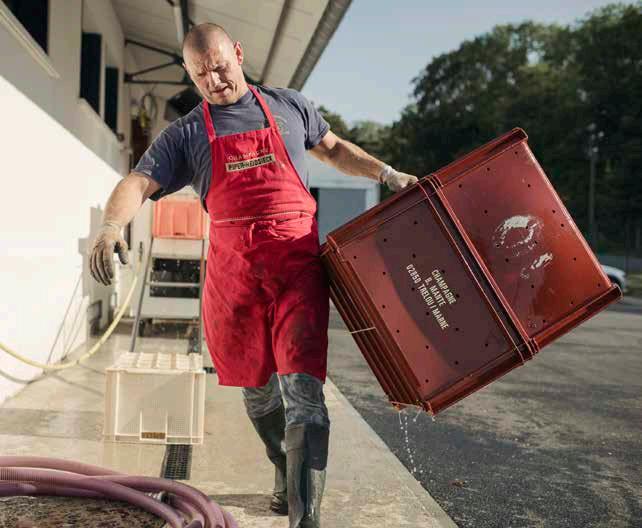
Antoinette as its first ambassador. HenriGuillaume Piper joined the company in 1815, working closely with Florens-Louis’ nephew Christian to expand the champagne empire to become royal warrant holder to 14 royal and imperial courts. Since then, Piper-Heidsieck has worked with big names from Fabergé to Marilyn Monroe – who, in 1953, said: “I go to bed with a few drops of Chanel No5 and I wake up each morning to a glass of Piper-Heidsieck.”
This new B Corp certification – which is also extended to the maison’s sister brands Charles Heidsieck and Rare Champagne, part of the family-owned EPI Group – is the latest avenue for advancement for a brand that seems determined to protect its vineyards and community for generations to come. As Benoît says: “Now, more than ever, we believe in taking inspired action to pave a new path forward by constantly adapting to enforce strategies that better our champagne production, while having a positive impact on the world.”
piper-heidsieck.com
24
NOW, MORE THAN EVER, WE BELIEVE IN TAKING INSPIRED ACTION TO PAVE A NEW PATH FORWARD
– Benoît Collard, CEO, Piper-Heidsieck

THE SPARK OF LIFE
We head to Goodwood Festival of Speed to meet Genesis, the luxury car marque bringing Korean hospitality to the world of high performance EVs
Words: Gabriel Power
It’s going to take a considerable amount of horsepower to wrangle petrolheads away from the visceral, controlled chaos of the traditional combustion engine and convince them to embrace the inevitable rise of electric vehicles. But, at June’s Goodwood Festival of Speed, I finally catch a glimpse of a future in which this improbable scenario plays out.
Standing on tiptoes to get a better view of Goodwood’s famous Hillclimb – which sees cars of all makes and vintages thunder up the track at speed – I can hear snippets of conversation from motoring journalists and car enthusiasts alike, all eager for each successive ear-destroyingly loud run to begin.
Soon, it’s the turn of the Genesis Electrified GV70. As one of only a handful of fully electric cars on display during the Hillclimb, the GV70 is eerily silent as it shoots up the hill and out of view; the crowd hushed by the peculiar yet oddly thrilling sight of such a muscular, powerful car producing so little sonic output, despite gunning it uphill at max speed.
ELECTRIFYING OWNERSHIP
With a unique take on car ownership and weaving what it refers to as “Korean hospitality” into its customer service model, luxury car brand Genesis has made a rather intriguing name for itself in the electric vehicle corner of the automotive industry. Though not solely an EV manufacturer, the Korean brand, which launched in 2015 and branched out into the European market in 2021, has produced a series of electric vehicles that meld luxury with environmentalism, affording drivers the ultimate in ride comfort and design with a clean conscience.
On this blisteringly hot day, Genesis has parked its rather fetching range of cars in a fanshaped row at Goodwood’s Orangery. Among the display is the versatile, high-performance GV60 crossover utility vehicle; the modern sedan G80 with its sleek profile; and – the pride of the bunch – the Electrified GV70, making its grand debut at the festival.
Described by the brand as having “athletic elegance”, the GV70 is an all-wheel drive compact
SUV that can charge from 10% to 80% in 18 minutes using a 350kW charger. And they are no slouches on the track, either; with up to 483hp in Boost Mode, this car can go from 0-60mph in 4.5 seconds – faster than the brand’s original gaspowered GV70 design.
While the unveiling of the GV70 is received with much acclaim, it is Genesis’s approach to car ownership that truly sets the brand apart from their competitors.
You don’t have to look particularly hard to see that Genesis is somewhat obsessed with the Korean concept of sonnim – which loosely translates as “hospitality” but, in reality, essentially takes the form of near-fanatic dedication to providing unrivalled customer service to Genesis owners.
The Genesis Care Plan, available to all buyers, includes scheduled servicing every 75,000km (with collection and return of the car to the owner’s door), 24/7 roadside assistance, and even a personal assistant who is always on hand should you come across any issues or have any questions. »
26


IN THE DRIVER’S SEAT
As the sun dips below the horizon on the GV70’s debut, Genesis’s UK director and regional operations manager, Andrew Pilkington, can barely contain his excitement as he lays out the journey he and the brand have been on up to this point.

“Last year we launched Genesis into the most competitive car market in the world: Europe, the home of premium luxury cars,” he says. “We launched not only as Genesis, but as the ‘Genesis Difference’, taking the form of a direct-to-consumer model that puts the customer at the centre of the business. We have the cars, of course, but we also have a luxury consumer experience.”
The most exciting aspect, for Andrew, appears to be the brand’s personal assistant scheme. “This person won’t come from a sales background; they’ll have come to Genesis through the hospitality and customer service sector. They’re here to help our customers through the buying and ownership processes,” he says, noting that this ties into Genesis’s philosophy of respect for the car owner. “We value our customers’ time. If you want a test drive, we’ll come to you. If you buy one of our cars, we’ll bring it to you. If your car needs a service, we’ll pick it up directly from you. And we’ll throw in a courtesy car while you wait.”
With Genesis’s third electric vehicle successfully unveiled, it begs the question: what are the brand’s aims?
“Three electric models have been launched
this year, indicating that we’re well on our way to our range being fully electric,” Andrews says. “I anticipate that by 2023, 95% of our sales will be electric. We believe the variety represented by our cars offers choice in a market where options are limited. But, of course, we’re all about choice – meaning that, should you want an internal combustion engine car, we’ll continue to offer those too.”
The evening grows longer as we chat about everything from climate change to Korean custom, with the consistent soundtrack of ferocious gas-powered cars echoing from the famous Goodwood circuit. Yet here, in this secluded enclave of thee, it feels exceptionally peaceful, surrounded by orange trees, a perfectly still outdoor swimming pool and an array of electric SUVs that, if powered up, would barely raise the ambient volume of the party by a single decibel. It’s about as close to sonnim as I can hope to experience at Goodwood, courtesy of a luxury car manufacture with an eye for hospitality and a robust, dynamic vision for the future that practically radiates off those associated with the brand.
Genesis may not represent the beginning of EVs in Europe – it has entered a market saturated with stiff competition – but its unique dedication to its consumers, much like its elegantly silent cars taking on the Hillclimb, are sure to turn heads for years to come.
genesis.com

29
MOTORING
Spirit of sonnim: The Genesis electrified GV70 debuted at Goodwood Festival of Speed
TRANSFORMING THE GAME
Former rugby player and founder of Parmenion Sports Management Matt Leek on how a new wellnessfocused approach is changing the game for ever

Professional rugby needs to change. It needed to change pre-Covid-19 and it certainly does now. It’s difficult to explain the unique pressures that player’s face at such a high level. I definitely struggled with that as a young academy player, and it’s inspired my approach to teaching, training and mentoring ever since.
Sport can be a strange environment, especially when you think about young players who are transitioning from, effectively, a school hobby to a professional career, just as they are turning 18. It’s no wonder that major transitions – from joining new teams to leaving sport for good – can also be difficult later on.
Although rugby is still seen as a very middleclass sport, we have players from all backgrounds and life experiences. They have different personal pressures and, as the games becomes more diverse and inclusive, we want to ensure that all our players are supported throughout their lives and be really personalised to their experiences and our approaches to supporting them.
In 2018, a study showed that 62% of rugby players experience mental health issues, and almost 50% experience financial struggles within five years of retirement. I saw this in my previous role with the Rugby Players Association, where I introduced the Mental Health First Aid (England) course into clubs across the premiership. In an environment where a lot of high-performance rugby players, club and off field leadership staff alike, can really benefit from sharing that kind of good practice and experiences with each other.
The inspiration behind my company, Parmenion Sports Management, was to create a very holistic, player-centred agency that doesn’t just support our clients’ current interests, but supports their career goals and future after rugby, through a range of mentoring schemes. We currently manage about 12 players, both men and women, and plan to grow slowly. Part of my approach is to work out who my clients are as people, not just as sportsmen and women. What are they good at? What do they enjoy? Are they an extrovert or an introvert?
The value of integrating wellness into
management is huge; a proactive rather than a reactive to the needs of our players, we want to try and build good habits within the sport, so that everyone has those tools ready for their mental wellbeing, whenever they need it.
ADVICE FOR LIFE
I had a state school upbringing before winning a scholarship at an independent rugby school. Later, I moved on to play for the academies at Worcester Rugby Club and then the Dragons, while spending a series of short-term loans in the Welsh leagues when I was about 19 years old.
At the time I left Worcester, I didn’t have any plans for my future beyond being a professional rugby player, but the brilliant lifestyle support officer Alun Davies encouraged me to think about my future outside of the sport. He helped me apply to university so, when I was ultimately released from the premiership at the end of my second year, I was able to develop other options.
For nearly 10 years I was a teacher, working with children from some non-traditional backgrounds as well as setting up a rugby programme across Bristol – some of the students I taught are now professional rugby players, such as England’s Ellis Genge, Mitch Eadie, Nathan Chamberlain, Tom Sims and Ed Harvey.
The programme wasn’t just for those players at a top level of rugby but offered holistic support for players to support them in their future careers – both within the sport and after it. We wanted to give our players a sense of belonging, raise aspirations and
develop their identity and this is what led me to work with the RPA, looking after the players’ wellbeing and, eventually, to establish Parmenion Sports Management.
CREATING CONNECTION
Another way we’re trying to transform the game is through an app-based sports market, Pella Pro. It connects clubs and players – professional and aspiring – so that communication and contact becomes easier and more organic. It doesn’t replace sports agents but is designed to provide extra support, that extra safety net, while opening up the worldwide market.
We have a virtual coach, a benefits area, and opportunities for players to speak to other players and get really valuable advice on subjects from finances to relocation to grief support.
Rugby is a very young professional sport, really – it was officially established in 1995 – and so I feel that we need to be more open to change. For example, there are many clubs suffering in current economic climate and so we shouldn’t be afraid to tweak the model if it helps us support clubs and players and move the game forward. There’s a lot of information around safety that we can communicate to players from an early age, and that will help us support grassroots rugby and encourage young players from wider non-traditional communities.
Supporting people is key. You only have to look to the Bristol Bears and Bath Rugby and how they came into the schools I worked in, to see how students started taking rugby more seriously, after being inspired by their players, that is creating a community legacy.
It's an optimistic time for rugby, but it's also quite a critical time. Women’s Rugby, for example, is bigger than ever – New Zealand’s Eden Park stadium was sold out for the Women’s World Cup Final in November –and it’s inspiring a whole generation of girls.
It’s time for all clubs to capitalise on that interest, make sure that we’re more open at grassroots level and, finally, make sure no one is left behind.
parmenionsportsmanagement.com pella-pro.com
30

OCEAN TRACKS
Combining luxury and practicality for tidal coastlines and land-locked boat lovers alike, we test Iguana Yachts’ amphibious solution to high tech seafaring

 Words: Rory FH Smith
Words: Rory FH Smith
From time to time, life on the ocean isn’t all plain sailing. While the world of powerboats appears to be as glamorous as it gets, Antoine Brugidou, founder of Iguana Yachts will happily tell you otherwise.
Originally from Normandy, on France’s Atlantic coast, Antoine has first-hand experience of the niggles associated with boat ownership. And we’re not just talking about the financial and admin side of things; what Antoine faced was a physical problem. Living in one of the most tidal stretches of coastline in the world, the engineer would struggle to launch his boat due to lack of access to the sea. With only a few marinas available, and space in them at a premium, local sailors typically tow their boats for long distances across rocks and mud to reach the sea.
It was Antoine’s will to overcome this problem
that led him to create Iguana Yachts and invent a craft that didn’t need to be anchored, towed or berthed – one that could be launched anywhere, tackling some tricky off-road terrain in the process.
MAKING WAVES
His vision initially took the form of a unique mobility system in 2008, the year he founded Iguana and, from there, the company went on to make its first boat – the Iguana 24 – in 2011. Mating a sleek, solid-hull powerboat with military-style tank tracks, Antoine had finally found a solution to his problem, albeit a rather unorthodox one. Armed with caterpillar tracks and a small inboard engine to power them, the Iguana could drive itself over the rough terrain and long tidal beaches of Normandy to launch itself with minimal hassle. »

While amphibious boats have existed for years, typically with wheels mounted onto legs that deploy when needed, the Iguana’s robust tracks make it capable of taking on more rugged landscapes – not to mention looking like something that Q-branch would dream up for 007. From the launch of the first model in 2011, the range has grown to include nine different boats, including RIBs and even a professional line designed for the security and rescue industries. Yet, while this relative newcomer to the motorboat world certainly looks the part, it’s true test is how it performs out on the water.

First laying eyes on the sleek, white and grey Iguana X100 in Berthon Marina in Lymington, there’s little to set it apart from the hundreds of other glimmering craft moored up. Measuring
in just under 10m long, the boat sports a solid, carbon fibre-reinforced hull with an inflatable RIB collar – much the same as other craft around it. But it’s on closer inspection, just above the waterline, that you can catch sight of the secret to the Iguana’s versatility: its tracks.

Once on board, and with the X100’s twin 300hp Mercury Pro XS engines all fired up, we’re ready to set sail for the Solent. With 600hp behind it, the X100 is no sloth in the open water despite weighing 3.5 tonnes. Reaching top speeds of 50 knots is a smooth process, with the X100 remaining planted as you ease the throttle forward and feel the pace pick up. With room for 12 people on board and sizable storage areas, this is a capable and comfortable day cruiser.
Shore to sea: The Iguana ranges includes the X100 (previous), the Sport (left and interior) and the Commuter (above and right)

SEA LEGS
Soon enough, it’s time to experience the X100’s party piece and put its amphibian abilities to the test. Looking for the ideal spot to make an unplanned landing, we approach a slipway, cutting the engines to a crawl as we get closer.
Pushing down on a button on the dashboard, there’s a bleep before we start to feel the two metal legs drop down into the water like a plane’s landing gear. Taking only eight seconds to deploy, once the tracks are in place I ease forward on two separate throttles – one to control each track –and the inboard motor hums as the caterpillar tracks rotate and bite onto the surface with a reassuring clunk. Gradually, like something from a Bond movie, the X100 steadily hauls itself out of the water and onto dry land, tipping over
34
the crest of the steep slipway and continuing onwards down the road to the boatyard.
As eye-catching launching from dry land as it is emerging, the X100 can launch nose or rear first. My relative lack of experience leads me to reverse into the water, ensuring the engines are well submersed by the time I fire them up for a speedy getaway from the crowd that has assembled on the seawall.
While the X100 might have blended in moored in the marina, it’s a different story when you’re looking down on cars and passers-by from behind the wheel of an amphibious, luxury landing craft. Capable of dealing with 40% inclines, rough rocks, mud and beaches alike, there aren’t many places the Iguana can’t land or scurry across.
Though it may have been born of frustration, Antoine has successfully developed a slick solution to a problem that many estuary dwellers and land-locked sea lovers face. While the X100’s €320,000 price tag might seem steep, Antoine’s mating of two very separate engineering solutions is as remarkable as it is practical –not to mention its ability to turn heads in the harbour, beach or wherever you choose to land.
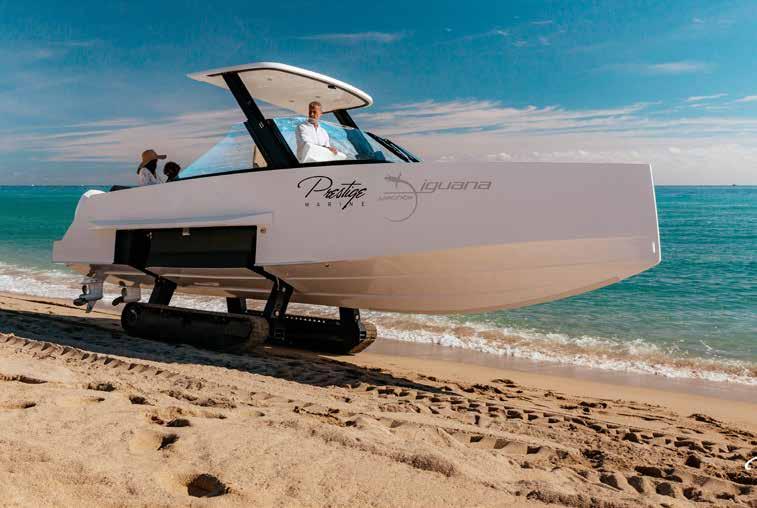
In an age where sensibility and financial restraint often suffocate creativity, inventions like the Iguana are a rare glimpse at what’s possible when willpower and ingenuity ignite.

YACHTING
iguana-yachts.com
A CINEMATIC PARTNERSHIP
As Swiss watchmaker Omega celebrates 60 years of James Bond, actor Daniel Craig shares his favourite models and reveals his own timeless style
Report: Michelle Johnson
Ablack tie gathering under cover of darkness at a secret London location, attended by the best and brightest from the worlds of cinema, watchmaking and business alike; the night could be the start of a scene straight out of a new James Bond film.
It’s a fitting comparison, for 007 actor Daniel Craig was the guest of honour at the secret spy-themed event on 23 November, hosted by Swiss watchmaker Omega to celebrate 60 years of James Bond on screen. The glamorous evening paid tribute to the franchise’s 25 films, produced by EON Productions – first founded by Albert R Broccoli, the driving force behind bringing Ian Fleming’s thrilling novels to the big screen, and now led by his daughter Barbara Broccoli and stepson Michael G Wilson to resounding success.
The evening saw guests enjoy authentic props and gadgets straight out of Q-Branch, as well as discover the full line-up of Omega watches worn on screen by Fleming’s superspy character through the years – including two new Seamaster Diver 300m “60 Years of James Bond” watches produced to mark the franchise’s anniversary.
The first (right) is stainless steel with a 42mm case, with bezel and dial both made from blue oxalic anodized aluminium. The watch features laser-engraved waves on the dial and a Super-LumiNova diving scale on the bezel, and is completed by a mesh-style bracelet. The second variation comes in 18k Canopus Gold – the brand’s exclusive white gold alloy – with a grey silicon dial designed as a nod to Fleming’s Jamaican home, Goldeneye. The bezel is paved with green and yellow treated natural
diamonds in a variety of tropical shades. The iconic spinning gun barrel scene plays beneath the sapphire, thanks to a patent pending microstructured metallisation, known as a “moiré” effect animation, linked to the movement of the lollipop seconds hand.
Omega has partnered with Bond since 1995’s GoldenEye, when Oscar-winning costume designer Lindy Hemming equipped 007 (played by Pierce Brosnan) with an Omega Seamaster Diver 300m Quartz. Hemming believed the diver’s watch was the most suitable choice to compliment the character’s naval background, saying she “was convinced that Commander Bond, a naval man, a diver, and a discreet gentleman of the world would wear this watch”.

Omega has adorned Bond’s wrist ever since, with Pierce wearing models including the Seamaster 300m Chronometer (Tomorrow Never Dies , The World is not Enough and Die Another Day) – complete with laser – and Daniel opting for the Seamaster Diver 300m Co-Axial Chronometer (Casino Royale), the Seamaster Planet Ocean with black dial (Quantum of Solace), the Seamaster Aqua Terra 150m with blue dial (Skyfall), an explosive Seamaster 300 “Spectre” Limited Edition (Spectre) and an electromagnetic Seamaster Diver 300m 007 Edition for his final film, 2021’s No Time to Die
“Our partnership with EON Productions and James Bond is something totally unique within watchmaking,” says Raynald Aeschlimann, president and CEO of Omega. “It’s a chance to be creative and have fun, while highlighting our qualities of style and reliability. We love to bring
that partnership to life on nights like this.”
Guest of honour Daniel (opposite) – notably wearing the stainless steel 42mm Seamaster Diver 300m on his wrist – joined Raynald on stage to welcome stylish guests including actors Hayley Atwell, Daisy Edgar Jones, Oliver JacksonCohen and Will Poulter.
Daniel, who has portrayed James Bond over five films since his debut in 2006’s Casino Royale and is now an Omega ambassador, says: “It’s been a joy for me to work with Omega in all the films since Casino Royale James Bond is a character who likes the very best of everything, so it’s always made sense that he would wear something as beautiful and trustworthy as an Omega.”
Here, Daniel shares his thoughts on the longevity of James Bond and his favourite Omega watches… »
36



What makes James Bond and Omega so perfect for each other?
Bond needs a watch that keeps the time. He needs a watch that’s going to stand up to the rigours of his job. Every Omega I’ve ever worn in Bond has always kept going – even though we’ve bashed them around. They’re very beautiful. He puts himself up to a very exacting set of standards and that’s exactly what an Omega watch is.
Who decides the role for the watches in the movies? Is it a collaborative process?
Omega gets involved. We always have a conversation about it. A Bond movie isn’t really a Bond movie without gadgets, and right there at the apex is Omega. Even if it’s just telling the time, it becomes an important part of the storytelling.
We saw the classic Aston Martin DB5 in the recent movies. Is there a vintage Omega watch that you think would suit James Bond?
I’ve got a 1969 Seamaster which I wear constantly, which is still going beautifully.
What’s your own choice of Omega watch when you’re not on screen?
It’s that one, or the watch I wore in Spectre Again, it’s a Seamaster, but it’s got the Nato strap on it. I just like the Nato strap. It dresses it down a bit.

Regarding 60 years of James Bond; do you ever watch the old movies? I’ve watched them many, many, many times. Especially when we’re filming, I always go back and watch them again before we do a film.
What is the secret to James Bond’s lasting popularity?

That’s a big question. But the way that the Broccolis keep making the movies, they’re always events, they’re special occasions. Everything from the watches to the cars, to the theme song. When they come out, they’re a huge talking point. And, so long as they maintain that, they’re going to last another 60 years at least.
omegawatches.com
– Daniel Craig
Time to thrill: Daniel Craig and guests including Hayley Atwell (below) admire the new Omega Seamaster Diver 300m “60 Years of James Bond”, which features a patent-pending “moiré” animation (left)
39
A BOND MOVIE ISN’T REALLY A BOND MOVIE WITHOUT GADGETS, AND RIGHT THERE AT THE APEX IS OMEGA.
WATCHES
IMAGES: COURTESY OF OMEGA
TIME WILL TELL
As Parmigiani Fleurier celebrates women’s watches, we take a closer look at the GPHG prize-winning Tonda PF 36mm
Swiss watchmaker Parmigiani Fleurier has maintained a long-held reputation for crafting elegant, stylish watches for both men and women, and has received plaudits for a number of models. The brand was originally founded in 1996 by master watchmaker and legendary timepiece restorer Michel Parmigiani, basing its business model on what it describes as a “sartorial approach to design”, affording the maison the opportunity to follow its own vision without being confined to the standard gender stereotypes.
Indeed, step into any of Parmigiani’s boutiques across the world and one will be welcomed by an array of stylish models suitable for any wearer. And with the brand having toiled away at the forefront of this trend for years, the movement is finally breaking into the mainstream, with multiple esteemed brands now also offering mixed-gender designs that vast swathes of the watch market have been asking for.
How this trend manifests itself can vary wildly, from smaller cases to a specific array of colours or materials used in a model’s creation. Parmigiani’s Tonda PF collection, launched in
2021, is a superb example of this shift toward ungendered designs, with a shimmering – yet not ostentatious – take on the modern unisex watch. And it is clearly turning heads in the women’s watch sector.
In November the maison graced the stage at the prestigious Prix d’Horlogerie de Genève (GPHG) 2022, to claim the award for best new design in the Ladies’ Watch category for its Tonda PF Automatic 36mm – the latest entry in the Tonda PF collection.
The Tonda PF Automatic 36mm is worth its weight in gold: as the name suggests, this new design is a smaller variation of the watchmaker’s flagship Tonda PF template. Parmigiani says the new design is the brand’s: “affirmative response to the many requests for a version of this timepiece in a format adapted to a slenderer wrist”.
The new model retains the wide dial opening and subtle chromatic variations which made the original line famous and features extraordinary guilloché dials with baguette-cut diamond hour markers. The new design also comes in three new colour variations; Silver Sand and Warm Grey – both steel versions with platinum bezels
– and Deep Ruby, for stand-out 18ct rose-gold option. All models are adorned with the PF logo, standing alone in the centre of a sapphire plate.
Under the hood of this sleek but dainty model, meanwhile, is a different beast altogether. The brand has integrated its powerful new Calibre PF770 movement into the design – it was developed specifically to fit inside the new 36mm case and endowed with a 60-hour power reserve. Furthermore, the piece is water resistant up to 100m.
And more innovative and line-blurring designs appears to be just over the horizon. In a response to the Tonda PF Automatic 36mm’s GPHG prize, Parmigiani CEO Guido Terreni offered an optimistic, ambitious view of the Maison’s future.
“This award demonstrates that watchmaking has yet to reach the limits of innovation,” he said. “We simply need the courage to change our views and practices. Finding the creativity to meet great watchmaking challenges has always been in the DNA of Parmigiani Fleurier.”
parmigiani.com
40
PARTNER FEATURE

SYMBOLS OF CHANGE
The contemporary works of Andrey Laponov combine traditional skills, precious gold and ancient symbolism to create a thoroughly modern form of icon painting. Here, the Ukrainian artist shares his philosophical approach
 Words: Michelle Johnson • Translation: Claudia Dickson • Coordinated by: Peter Malmstrom
Words: Michelle Johnson • Translation: Claudia Dickson • Coordinated by: Peter Malmstrom
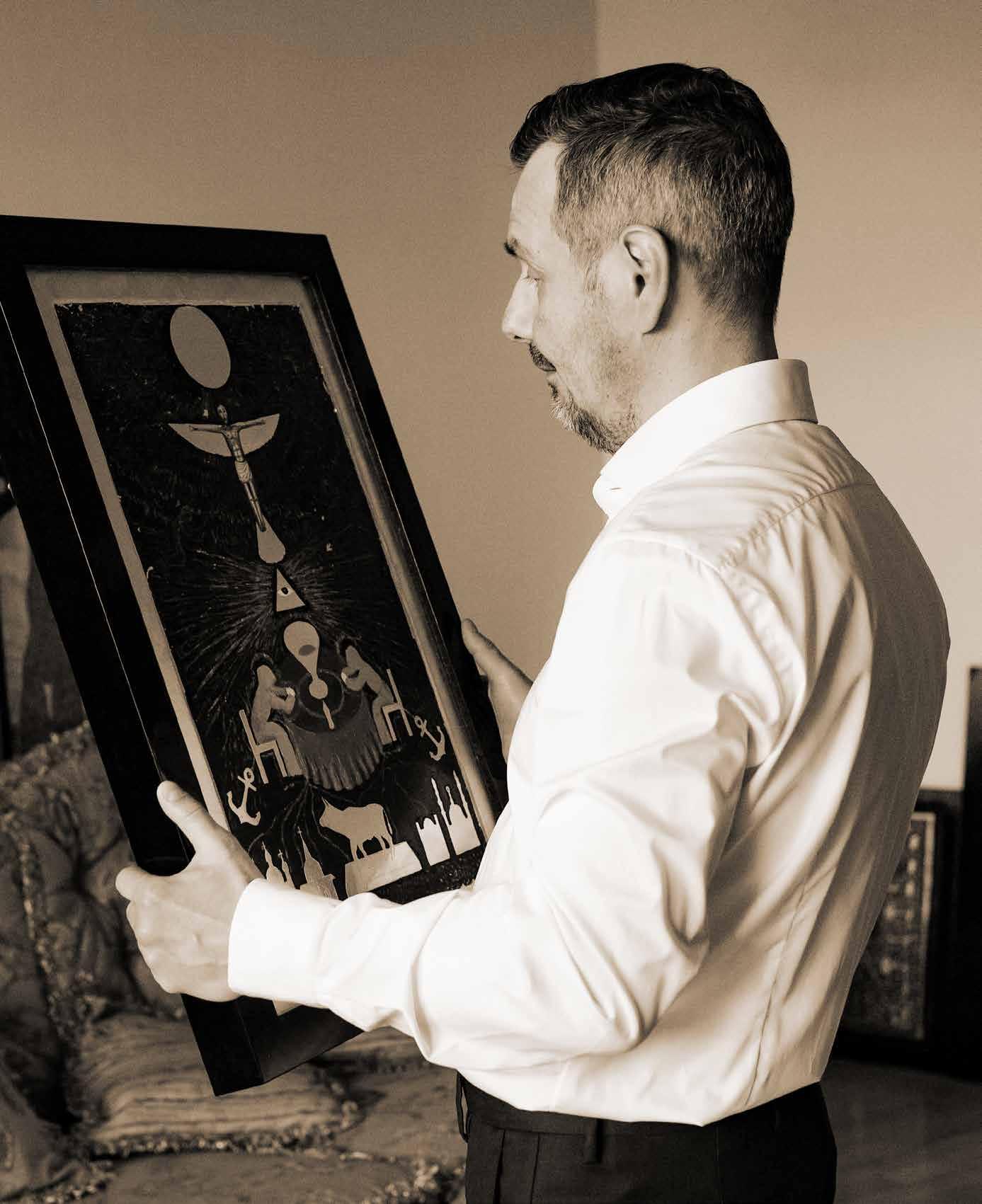
Throughout history, the importance of gold has been impossible to understate, spanning its allure in art and jewellerymaking, use as a symbol of power for world monarchies and religions, to its financial role as a sure investment in the modern age. In fact, says Ukrainian artist Andrey Laponov – who brings his contemporary icons to life through use of this precious metal – gold has an energy all of its own.
“Gold has a noble aura,” he says. “It absorbs the energies of the master during the stage of creation.”

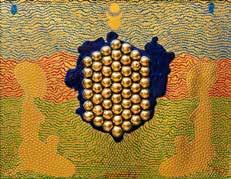


Andrey, 44, began his career in the 1990s as a realist painter before he decided to train with artists specialising in the restoration of religious icons. Highly technical and deeply symbolic, these devotional paintings of holy figures originated in Byzantine and Eastern churches from the third century. The process inspired Andrey to pursue an entirely new artistic direction, and he soon devoted himself to the creation of humanist icons that merged his philosophical studies with his evolving symbolist artistic style.
Fascinatingly, Andrey’s contemporary icons are made in the traditional way – oil paint on gold, applied to layers of levkas soil, on a base of wood procured from Ukrainian churches – but portray a cascade of symbols and signs taken from world history, religions and cultures the occult and science, in order to showcase a modern interpretation of the timeless and global connection shared by humanity.


Andrey’s works have been exhibited in Odessa Museum of Western and Eastern Art and Kyiv History Museum, as well as remaining in the private collections of his high-profile fans, including British actor Scott Adkins (Doctor Strange, Zero Dark Thirty). Now Andrey is setting his sights on the London art scene, after the escalating war in Ukraine forced the artist to relocate with his family to the UK and so begin a new chapter in his life’s work.
Here, we learn about the technical skill required to make a modern icon, how Andrey’s global symbolism bridges the gap between our inner and outer worlds, and how the bravery of the Ukrainian people is providing inspiration for his newest works. »
Artworks, clockwise from left: “Duhovnuy svit”, “Zolote telya”, “Boguinya Matir”, “Vichnist”, “Surpriz”, “Medutashiya”, “Lubov. Composichtiya 1”

45 ART

Andrey, how did you develop your icon painting style?
The foundation of my style was formed in childhood and inspired by the famous works of the Old Masters. I could spend hours with a magnifying glass, examining the details of famous art works and trying to replicate them.
I created my first original works of realism in the 1990s, but it was some time after that I trained with icon painters and restoration artists, honing my skills and learning the rules and principles of icon painting. The result of comprehending of all the subtleties in this type of painting was, for me, a second birth, and my interest turned from realism to symbolism.
How do you define your artistic approach?
My style is to consolidate modernity with ancient philosophical global teachings and embody all this in my paintings. Since the moment I walked away from narrative art, my whole artistic outlook and technique has changed dramatically. The turning point was my attempt to translate the accumulated knowledge I received studying such disciplines as cultural anthropology, ethnography, sociology of cultures, psychology, religious studies and occult practices. I wanted to translate this through the prism of fine art, and the incredibly rich artistic language of icon painting gives me the freedom and opportunity to focus on the global. This allows me to create expressive images and trace the connection with the subconscious mind.
Could you talk us through how you create your icons?
I use the classical techniques of icon painting, beginning with a wooden base – the symbolic image of the ‘Tree of Life’ – which represents a person reaching for spiritual enlightenment. Wood is a sacred material in most cultures, which means it carries the functions of an energy mascot. A layer of icon-painting soil called levkas is then applied to the wood to ensure it keeps its plasticity, and give luminosity and volume to the image. I make levkas from my own recipe, using the traditional components of chalk, oblique and mezzanine adhesives, vegetable oils, honey
and more.
Once each layer of levkas has finished ageing, I carefully apply gold to the piece. This is crucial stage, both in terms of technical excellence and symbolic energies.
How significant is gold as a symbol within your work?
Gold – known as Aurum in Latin – represents the cult of light, sun, fire and purification. This is a very powerful conductor of energy, because dozens of generations are bound together by the symbology of this noble metal. I have studied the symbols of different cultures and concluded that gold has always played an important role, both in an occult and utilitarian sense. There’s a long and uninterrupted connection between the aspirations, hopes and prayers of adherents of Christianity, Islam, Judaism, Buddhism, Zoroastrianism and more. For me, it is also important to emphasise the role of gold in contemporary life: namely as a non-objective cultural artifact, as a human fixation.
What draws you to different cultures and spiritual movements as inspiration? I am inspired by the cultural diffusion of knowledge of such matters as good, evil, power, wealth and divinity. The source of my inspiration is knowledge drawn from different cultures. I had the opportunity to get acquainted with Buddhist texts, and the literature describing Taoist practices, and, of course, with the monographs of Hermetic scholars. I like to combine the ancient with the contemporary, to trace the connection of different times and find semiotic combinations that build a bridge over the abyss of centuries. Through symbols, I engage in a dialogue with the viewer about the relevance of pantheism today, about sleeping knowledge, and the transformation of mental energy.
Are there any artists that influence your style?
I am endlessly fascinated by the Old Masters, especially by their boundless desire to achieve perfection: the ideal composition, the colour scheme, light and shadow modelling. They were innovators of their eras. However, the pace of
“4 storonu” (left) by
life was much slower then. In their philosophy, the closest and stylistically ‘related’ to me seems to be Wassily Kandinsky (1866-1944), Marc Chagall (1887-1985), Joan Miró i Ferrà (18931983), Gustav Klimt (1962-1918), and something from the heritage of American expressionist Jean-Michel Basquiat (1960-1988).
The Soviet avant-gardists stand apart: Kazimir Malevich (1879-1935), who pioneered cubism and futurism, El Lissitzky (1890-1941), and the early work of Wladimir Burliuk (18861917). In a way, each of them gave me the keys to opening new doors to the understanding of my own potential. I admire and bow to them as a spectator and listen as an experienced student with my own opinion.
Do current events – such as the war in Ukraine – impact your art?

What is happening in my homeland is beyond comprehension. My country, my people, are truly stoic. The growth of my inspiration is thanks to every individual that has been touched by the brave and unnecessary sacrifices that are happening at this very moment. I have a few ideas in mind for future artworks that acknowledge the power of unity and spirituality of humankind, which is timeless.
You are currently based in the UK. Could you tell us a little bit about your plans for the near future?
As you can understand, my move was unplanned and scrupulous, due to the war in my country. The endless sounds of sirens, constant threats and the actual shelling of my hometown, Odessa, made my family’s life unbearable, and I had to leave everything behind for their safety. The choice was very clear. I am so grateful for this opportunity to live and feel safe [in the UK] and for the tremendous support that the UK has provided to Ukraine and its people. Since moving to the UK, I have embarked on a longplanned and immersive field of research for my next artistic project, which is very exciting.
For more information on the artist, or to purchase existing works and arrange commissions, please contact Vantage Media via michelle@vantagemediagroup.co.uk
47
ART
THE FOUNDATION OF MY STYLE WAS FORMED IN CHILDHOOD AND INSPIRED BY THE WORKS OF THE OLD MASTERS. I COULD SPEND HOURS WITH A MAGNIFYING GLASS, EXAMINING THE DETAILS OF FAMOUS WORKS
Gold standard:
Andrey Laponov (inset)

BAHAMIAN VISION
Words: Lauren Jade Hill
“In the Caribbean, there’s a need to specify a nation’s identity and move away from that vagueness of the Hollywood Caribbean experience,” says the artist John Cox, who is leading my tour through Baha Mar’s impressive collection of art. “What we’re trying to do is let art and culture inform the experience people have in the Bahamas and even use it to define who we are as Bahamians.”
This artist-curator is the executive director of arts and culture at the Rosewood Baha Mar and, earlier this year, he was named the brand’s inaugural Rosewood PlaceMaker. An extension of Rosewood’s A Sense of Place philosophy, the PlaceMaker programme works with key community figures to showcase local culture through curated experiences.
Here in the Nassau resort, this programme includes the Hussey Art Tour, introducing the work of local artists through a tour and printmaking workshop, and the Current Art Gallery Sip and Paint Experience led by resident artists. Inspired By Talks bring creatives together in the hotel’s Library lounge and the Black Gloves Suite Series sees a ninth-floor ocean-view suite of the hotel become a platform for Bahamian artists, while also illustrating the Current Art Gallery’s curatorial services.
PICTURE PERFECT
I join John on a tour through this oceanfront enclave to discover the stories behind some of the Bahamian artworks on display and to hear from the artist himself about the overall mission of this creative resort-wide endeavour. As he leads us through each art-filled space of Baha Mar, starting in Café Boulud at the Rosewood hotel, stories are shared through these eclectic artworks and insight is given into what the nation’s artists want to express through these paintings, prints and sculptures.
“Baha Mar has been very supportive of this idea of moving art and culture to the table,” enthuses Cox. “That’s a great thing because there are all these strong Bahamian artists working in their practices here and then, with the diaspora, are all over the world. What we’re trying to do is curate the entire resort with Bahamian art.”
Each tour introduces you to some of the hundreds of Bahamian artworks across both the Rosewood hotel and the wider Baha Mar resort. As well as being home to two other hotels (Grand Hyatt and SLS), the resort encompasses a wealth of restaurants, boutiques, bars and entertainment venues, a water park, Jack Nicklaus Signature golf course, ESPA spa, casino and, among all of that, the prominent
Current Gallery & Art Centre. This gallery was joined in October 2022 by the brand-new Eccho art museum.
The Current Gallery & Art Centre promotes Bahamian artists through regularly changing exhibitions, sells the work of local artisans in the gallery boutique, and hosts print-making sessions in the on-site studio. The gallery’s Black Glove Service provides curatorial services for home, office and commercial space, from the original production and framing to transportation and installation. Artists’ work is also available for purchase through The Current Gallery’s online store.
A first for the Bahamas, this gallery also has an art residency programme, allowing local and international artists to create work in the gallery’s studio space that culminates in exhibitions, lectures and workshops for guests of Baha Mar.
In the resort’s convention centre, artworks making up the Fairwind Exhibition take you through over 150 years of Bahamian art and culture. The new gallery, Eccho, adds to this already impressive collection of artworks with a new art collection exhibited in partnership with the National Art Gallery of the Bahamas. This significant space of vibrant work also encompasses an art studio and lounge. »
49 TRAVEL
How Baha Mar is launching Bahamian creativity to an international stage as the nation celebrates a turning point in its contemporary art scene
CARIBBEAN STYLE
Set on Nassau’s white-sand Cable Beach, the Rosewood enclave of Baha Mar brings together a collection of 226 guest rooms, suites and villas set around tropical gardens and private cabana-lined pools. In architecture and interiors designed to feel like an island estate, facilities span four dining venues — Café Boulud of internationally acclaimed chef Daniel, which opened in 2021; the Latin American restaurant Costa serving coastal cuisine; the sophisticated Manor Park offering classic handcrafted cocktails; and The Library for afternoon tea — along with a Sense Spa and series of indoor and open-air event spaces.


As well as activities focusing on arts and culture, experiences here range from exploration of the local area to culinary encounters epitomised by the first ever Bahamas Culinary & Arts Festival presented by Baha Mar, which took place in October 2022 and is on the cards for the autumn 2023.
The hotel’s Bahamian art collection, curated by John, encompasses around 100 diverse pieces of work by 25 artists, including the Bahamas’ first abstract expressionist Kendra Hannaand, the Nassau-born artist Kendra Frorup – who expresses the inspiration she takes from the Bahamas in sculpture and print-making –as well as the rising Bahamian portrait and documentary photographer Melissa Alcena.
“The Bahamian architect, artist and cultural activist, Jackson Burnside, once said that by the time we get to 2020 more people will be coming to the Bahamas for its art and culture rather than just the sun, sand and sea,” says John. “That may not have been the case by the year he predicted but that’s really what we’re trying to accomplish now.”

Overall, these efforts build on the international prominence of the contemporary art scene that’s flourishing in the galleries and studios of Nassau – a city that holds UNESCO status as a Creative City of Crafts and Folk Arts and one that’s home to cultural sites including the colourful Straw Market.
Alongside prestigious arts sites such as National Gallery of the Bahamas, Tern Gallery and The D’Aguilar Art Foundation, Baha Mar helps heat up the local contemporary art scene. Together, these sites foster a creative community that’s eager to represent Bahamian culture on a local and international stage, while also deepening people’s understanding of this nation’s heritage and culture through artistic expression.
50
rosewoodhotels.com
THERE’S A NEED TO SPECIFY A NATION’S IDENTITY AND MOVE AWAY FROM THAT VAGUENESS OF THE HOLLYWOOD CARIBBEAN EXPERIENCE
– John Cox, artist and curator
Art and identity: John Cox with artist at The Current Gallery (main); The Rosewood Baha Mar’s stylish library (top) and Café Boulud (above)
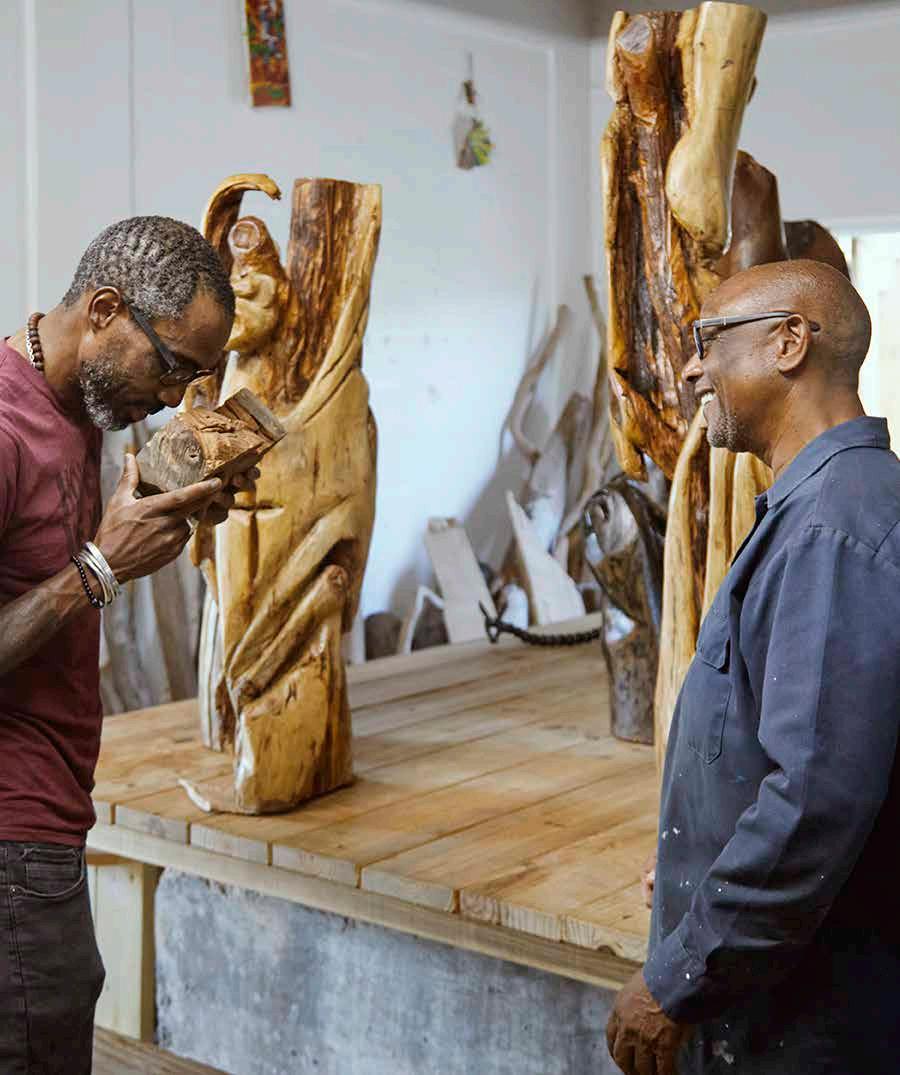
SETTING SAIL
From extended excursions to embracing the Metaverse, the superyacht industry is emerging from troubled waters to bring a new wave in ocean lifestyle. We head to Monaco to navigate the most important trends for 2023
Words: Judy Cogan
The superyacht industry hasn’t had an easy year, with multiple vessels linked to Russian oligarchs being sanctioned and urgent calls for greater sustainability among its challenges. But, proving yachts are as invincible as they are utterly glamorous, the tide is changing.
This year’s Monaco Yacht Show, themed “seducation” (education and seduction), showcased more than 100 superyachts including the stunning new 62 metre RIO designed and built by CRN (pictured).
Alberto Galassi, CEO of Italian ship builder Ferretti Group (which include CRN and Riva, among other yacht brands), revealed a major “boost” in client interest and says the company is set to end the year on a 50%-plus high. While many shipyards predict 2023 will be the most lucrative yet.
What’s next in the world of superyachts? Here, with the help of key industry experts, we reveal the top yacht trends being floated for the year to come. »

52

53
ENTERTAINMENT
Superyachts come with crews trained to anticipate every request, Michelin-star-worthy cuisine and panoramic ocean views. But now yacht owners are focusing on entertainment that includes sprawling beach clubs, live DJs and even magicians who can levitate furniture and perform card tricks. The yacht experience is also becoming more immersive, driven by the increased role of AI and virtual reality onboard.
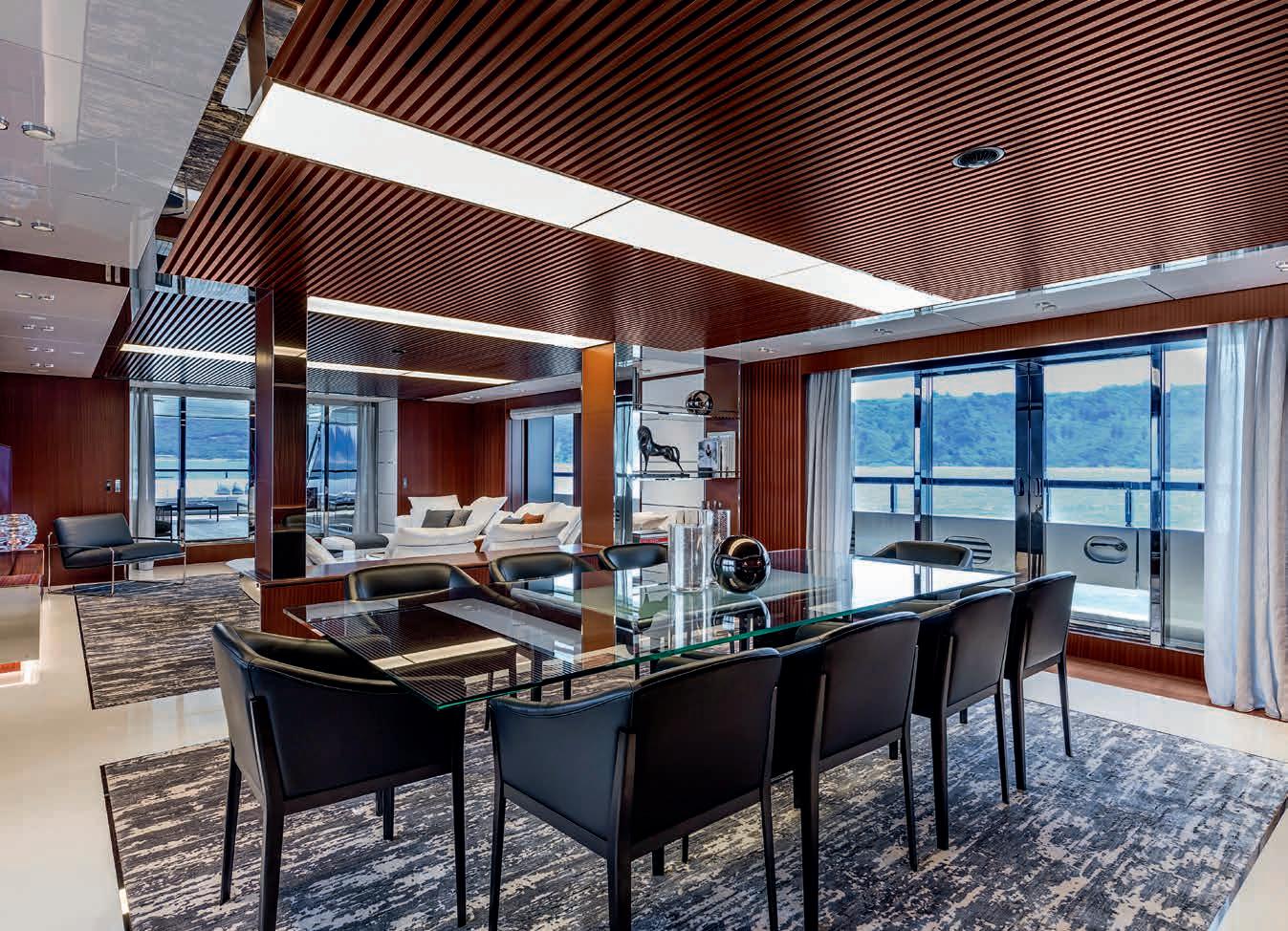
Superyachts like the latest CRN yacht, RIO, even feature extensive outdoor areas with spa pool zones and open-air cinema.
YOUNGER OWNERS
On the Forbes 400 this year, 10 billionaires listed are under the age of 40. The rise of wealthy young sports stars, actors and tech-savvy whizz kids has lowered the age of superyacht owners by 10 to 15 years over the past two decades. This is changing the face of yachting, with formal dining and stuffy dress codes out and consciously made cuisine, remote working spaces and city apartment style interiors very firmly in.
OFF-GRID DESTINATIONS
Charlotte Thomas, The Superyacht Life Foundation says: “There’s no denying the cornerstone destinations in yachting are the Mediterranean and the Caribbean. But we are seeing more owners seek out harder to reach places, particularly across the Pacific, from French Polynesia down to Australasia, Indonesia and Philippines. Raja Ampat, in eastern Indonesia, is a paradise on earth with no hotels, towns or cities and its only accessible by boat.
While some are heading to Antarctica. Adventurous destinations tie into the new desire for a completely unique experience. No one can fly to Antarctica and spend a week on the ice, but you can go do it on a yacht.”
Seas the day: New technologies and sustainable fabrics are inspiring yachts like the Riva 50’ (left) and 76’ (right)
54
NEW TECHNOLOGIES
In 2023, we’ll see iPad-controlled lighting and sound systems as standard. Cloud-based platforms will replace piles of paperwork when it comes to itinerary planners, navigational software and security systems. The metaverse is being embraced with yacht-specific NFTs, cryptocurrency and marketing campaigns devised using VR and AR to attract younger owners and offer something completely new.
INTO THE METAVERSE
Alberto Galassi, CEO of Italian shipbuilder Ferretti Group shares his view:
“This is something that cannot even compare with the pleasure of living, touching, owning, sharing and enjoying a real yacht. How can you own something that doesn’t exist? I’m an old dog, but even I am waking up to this technology and 3D parallel worlds are going to become our reality. We will use this technology to show the product off and reach potential owners earlier in their life.”

LIFESTYLE TRENDS
Covid-19 has made a huge impact on how yacht owners use their vessels, with longer periods of time now spent at sea and a greater desire for freedom and privacy. Alberto Galassi amplifies this sentiment in saying owners and potential owners have realised the value of a yacht as their own “private island”. People want office space with lightning-fast wifi, but also space to entertain and a master bedroom with acoustic privacy. Brand new yachts for next year will also feature foldout sea terraces for ample sunbathing space. »
EXPERIENTIAL TRAVEL
On experiential travel Friso Visser, CCO of Heesen, says: “Over the past four years, we’ve also seen an increase in interest for crossover yachts that can take owners and their guests further away from the Mediterranean and Caribbean shores to the adventurous waters of the Arctic Ocean or the Galapagos islands. Experiential travel is a growing market so we have partnered with Winch design to create a yacht that has all of the luxury amenities you would expect from a Heesen yacht, combined with the power of an all-terrain yacht. Our newest concept, XV67, will offer the best of both worlds.”
YACHTING
WELLNESS
For wellness facilities worthy of 2023 we’re talking health clubs as impressive as many fivestar hotel spas equipped with saunas, steam rooms, cryotherapy chambers, hammams, plus gym space, massage tables and calm rooms. Crews are expected to be multi-skilled: a deckhand who doubles up as a diving instructor or a steward who’s also a trained masseuse. Cooks onboard are expected to adapt to specific dietary requirements and more people are requesting noise and vibration reducers to create a bubble of zen onboard.
HOME COMFORTS
Standard one-size-fits-all interiors are being replaced with more of a focus on personal detail. Original artworks and sculptures onboard, custom-made hand-painted wallpapers and themed rooms make way for yachts being treated as homes not status symbols. Officina Italiana Design founders Mauro Micheli and Sergio Beretta (below), who are responsible for crafting the signature interior design of the world-famous Riva yachts, will be leading with a “less is more” approach. “We don’t like showy boats brimming with solutions inspired by pure formal virtuosity,” says Mauro. “We don’t indulge in gratuitous connotations just to make a splashy impact. We love classic, rigorous, clean design.”


MATERIAL WORLD
Officina Italiana Design co-founder Sergio Beretta says: “A major design trend we are focusing on for 2023 is the connection between exterior and interior spaces. They are no longer being used as two different places and need to feel that way. People are staying on board for longer and want a comfortable private space, maybe less flashy, but with all the same quality. Art collections onboard are popular because art is so personal and emotive. It’s about bringing your personal life onboard and connecting. Owners are also more sensitive to the environment and nature and feel a responsibility to live on the boat in a sustainable way. There’s an upturn in new and recycled materials, such as nylon, still made in a very luxurious and elegant way.”
56
THE RISE OF WEALTHY YOUNG SPORTS STARS, ACTORS AND ENTREPRENEURS HAS CHANGED THE FACE OF YACHTING
Waves ahead: Officina Italiana Design founders Mauro Micheli and Sergio Beretta (inset); modern luxury on the Riva 50’ (above) and 76’ (right)
SUSTAINABILITY
This year’s Monaco Yacht Show featured a new exhibition called The Sustainability Hub dedicated to showing how the industry is becoming more eco-friendly, such as electric and hydrogen-power solutions. While solar panels and wind turbines are great additions to power up boats without using fossil fuels. Everything from finding ways to build lighter yachts that use less fuel and recycled textiles are being explored. Yacht owners also are offering financial support to ocean conservation programmes.

GREEN GENERATION
Dilan
says: “For me the most exciting thing is to see the kind of community we are becoming. The new generation of super yacht owners are more adventurous in going to more remote places and so more exposed to nature and wildlife. They now understand the urgency to do something about preserving the environment and participate in local ocean conservation projects and invest in scientific resources. Their yachting experience is much more purposeful.”
YACHTING
Sarac, Marketing Manager at Superyacht Life Foundations

LIVING ROOMS
International interior designer Manuela Hamilford can turn any property into a modern masterpiece. The founder of Hamilford Design tells us how UK style compares to our overseas neighbours and how to make more from minimalism
 Words: Judy Cogan
Words: Judy Cogan
Manuela Hamilford has excelled in luxury home furnishings and interiors for decades. From revamping listed London homes and New York brownstones to recreating English country estates in Italy, she’s the person to have on speed dial when renovating a home.

Her London-based design studio Hamilford Design, open since 2000, offers services in design, architecture and renovation with a signature touch of elegance and warmth. The team is currently juggling 12 projects including a large house in Majorca and a property in Windsor that’s being transformed into a replica castle.
“We’re always busy and every project is
completely different,” Manuela says. “The house in Majorca is in-keeping with a traditional Spanish look but, in Italy, the client wants a quintessentially English estate overlooking a vineyard, which is absolutely stunning.”
Manuela approaches each project with an experienced eye in both furnishings and interior design and a clear vision of what her client wants. “I will meet them and get a feel for their remit and the space itself. Projects like the replica castle in Windsor are just crazy, but we’ve also done really quick 12-week turnarounds of central London flats, which are really fun and always challenge our creativity. It’s absolutely about making a smaller place sparkle like a jewel.” »
59 DESIGN
OCEANS APART
Manuela notes the differences in client demands between the US and UK. Across the pond everything is on a much larger scale, she explains.
“Americans love anything oversized. Houses in the Hamptons tend to be second homes by the beach; the enormous scale of them gives us scope to introduce beautiful bespoke furniture. We’ve brought in 4m-long dining tables made to order by local joiners.”
In contrast, her British clients lean into their lifestyle needs. “The properties we work on in the Cotswolds are often second homes, too, but they are driven by lifestyle,” she explains. “You have the muddy shoes, the dogs and kids running around, 20 bikes outside and a crowded boot room. These houses tend to be massive, with 4m-high fireplaces and enormous bunk beds that sleep 10 children.”
A particularly memorable and challenging renovation was at West Lodge, a 9,000sq ft grade-two listed building on the Thames River in Hammersmith, London.


“It’s a huge sprawling house and we faced several restrictions with it being listed,” she says. “We had a turret we had to keep intact, and certain trees aged over 100 years old that couldn’t be touched – all while doing a major refurbishment.”
Working on such an old house with a modern design vision isn’t always easy. “We wanted to move the kitchen into one of two large sitting rooms to create a much bigger space overlooking the Thames,” she recalls. “We had it all drawn up and it didn’t even occur to us to ask for planning permission. And then, of course, the architect said ‘no’ ,because it’s listed, so we had to keep the sitting room as a sitting room. That was an interesting project.” »

A modern classic: Grade-II Listed residence Westcott Lodge is transformed into a stylish oasis (previous and this page); colourful, informal dining at the Bohemian Retreat, Lakes by Yoo (opposite)

60

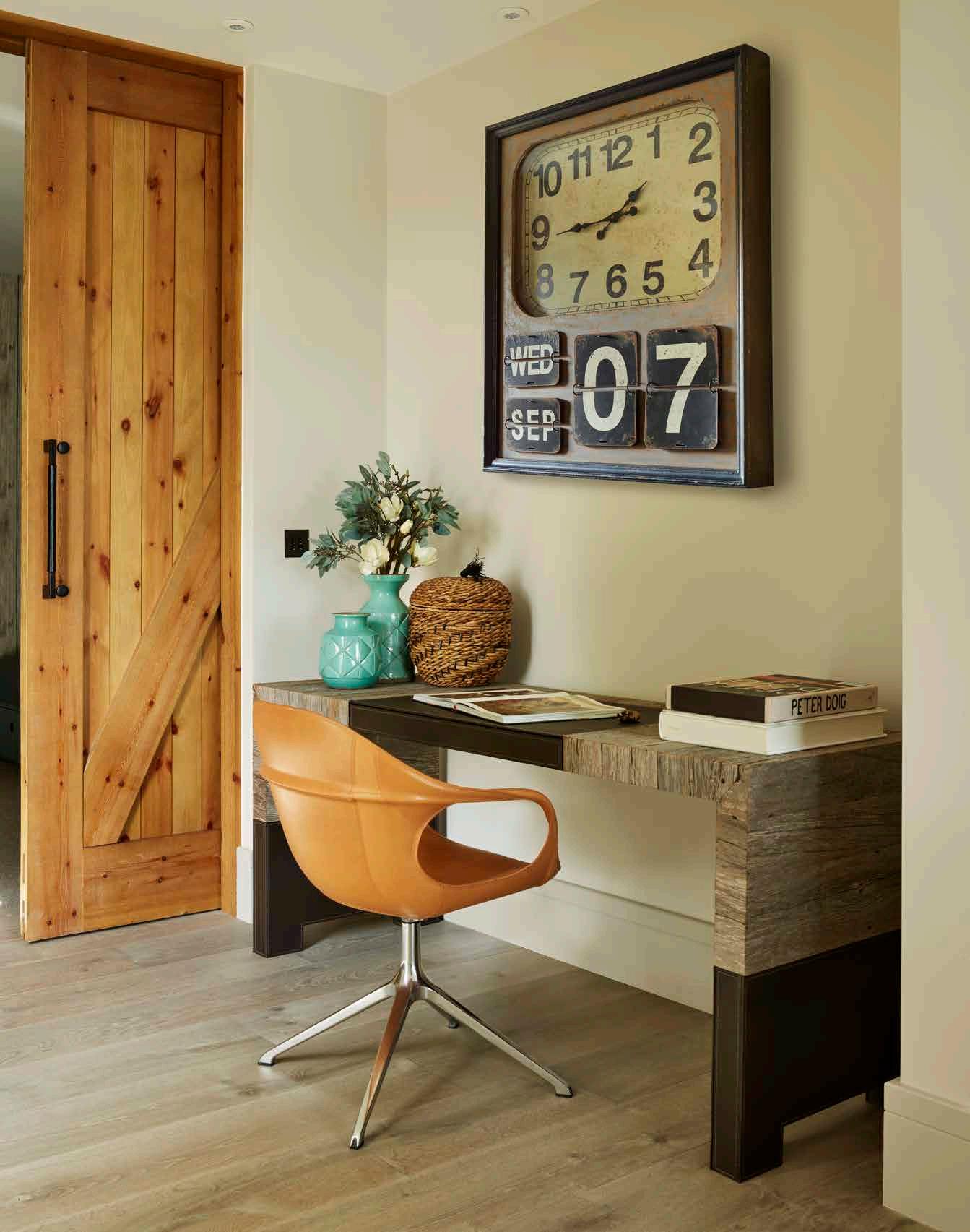
TRUE COLOURS
When it comes to adding colour to a home, Manuela advises a “less is more” approach. “Colour is great, but I’m not a fan of adding it everywhere all at once. It can be garish and hard to live with and it expires quickly. The overall design of a house must be cohesive.”
A mistake many of her clients make is to seek interior design inspiration from their favourite luxury hotels. “It’s easy to confuse a weekend at Soho Farmhouse with a place you can actually live in. Hotels are gorgeous, but I emphasise the question: could you actually live with such a bold design day in, day out? Can you imagine yourself waking up in this room every day and drinking your morning coffee? I normally take what they want and deliver a cleaner version.”
Manuela relies heavily on a team of loyal suppliers to get each job done. “They come into the studio to show us the newest wallpaper styles, paint colours and beautiful fabrics. As a team we’re constantly thinking up ways to channel them into a really contemporary look that’s inspiring and exciting.”
A major project for the studio was working on Lakes by Yoo, a new exclusive 850-acre luxury housing estate in the Cotswolds overlooking stunning lakes. The cabins, apartments and houses on the estate were the perfect blank canvas for Manuela.
“From the very beginning, my team was on the ground working out every detail. We started with the colour of the window frames, hinges and locks and built it up from there. They are very big spaces, so it takes a lot of work to make them feel cosy and warm.”
Manuela is constantly trying to find a balance between creating a functional space her clients can live in while staying ahead of the latest interior trends and lifestyle shifts. A major shift in recent years has been a return to the kitchen as the heart of the home.
“Across all the projects we’re working on, people are spending a lot of money on kitchens,” she says. “It’s the heart of the home and everything from the colour of the tiles to hot water tap fixtures are important. The mid-century look is very strong right now.”
The rise in working from home has also impacted interior design with work spaces a priority, but the biggest shift can be found elsewhere. “Children’s bedrooms have changed dramatically. Kids now want gaming areas and a separate place to study. Girls want a theatrical room where they can get dressed up and make videos to post on TikTok.
“It’s all changing, no two projects are ever the same,” says Manuela, who, it seems, wouldn’t have it any other way.
hamilforddesign.com


63
COLOUR IS GREAT, BUT I’M NOT A FAN OF ADDING IT EVERYWHERE... THE OVERALL DESIGN OF A HOUSE MUST BE COHESIVE
Back to nature: Natural materials make a statement at the Bohemian Retreat, Lakes by Yoo (this page)
DESIGN
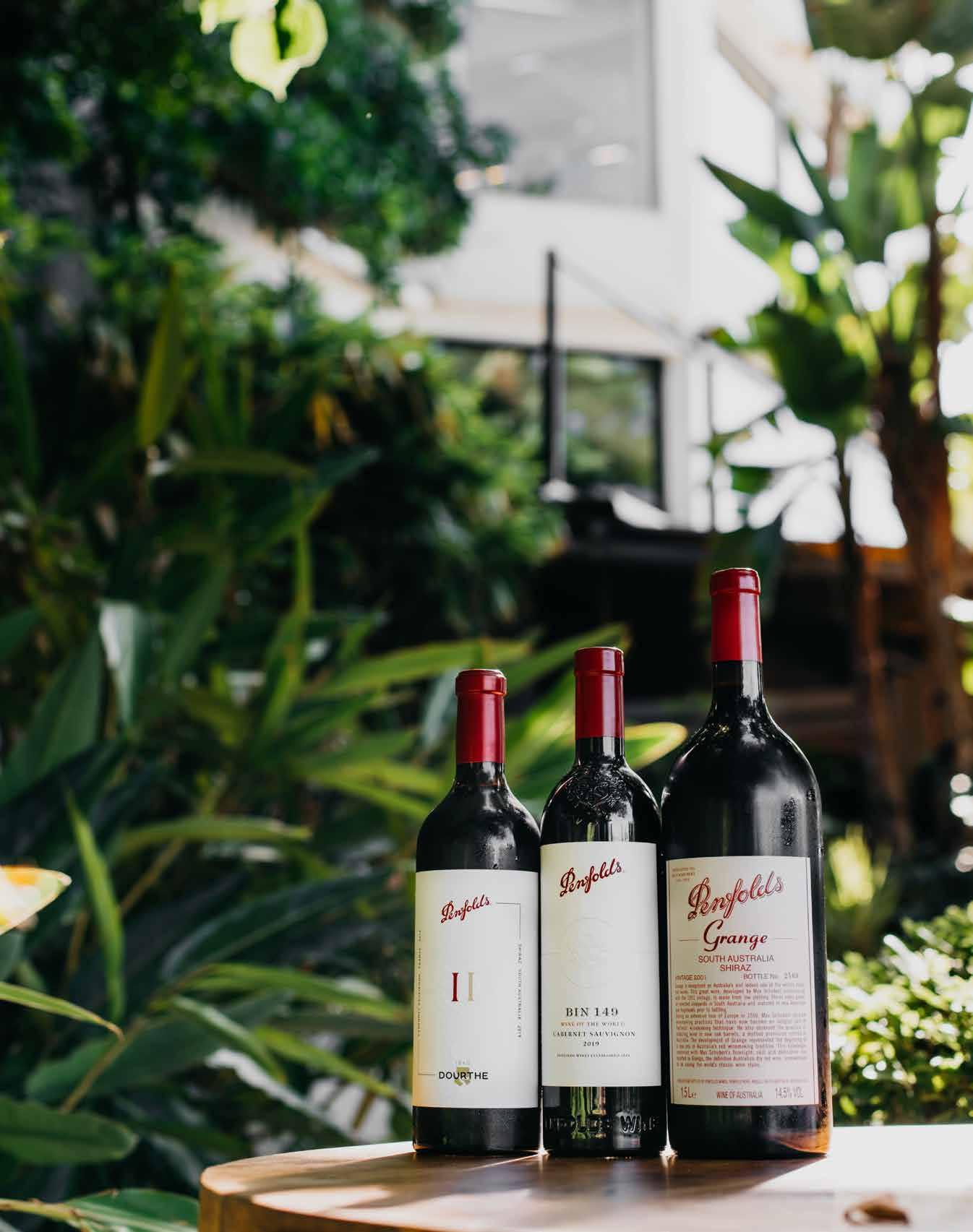
OLD WORLD NEW WORLD
Legendary Australian winemaker Penfolds breaks new ground in Bordeaux
Words: Nicole Trilivas
Penfolds is synonymous with Australia. With a winemaking heritage that dates back to 1844, Penfolds is one of the country’s oldest wine producers; and the brand’s flagship wine, Grange, has even achieved protected heritage status from the National Trust of South Australia — such is its iconic standing.
Yet, Penfolds is not one to rest on its laurels, however deep-rooted they may be. Every year, Penfolds debuts its latest vintages, and this year — on a sun-splashed afternoon dining at the French Riviera hotspot Mirazur — the brand introduced one of its most adventurous feats yet: its first-ever French wines.
Merging the new world with the old world and the southern hemisphere with the northern hemisphere, Penfolds’ new French offerings come from one of the world’s premium winemaking regions.
With a stylish label of signature red and sleek silver, Penfolds II is a collaboration between Penfolds and respected French winemaking house Dourthe Bordeaux, and blends Cabernet Sauvignon (60%) with Shiraz (28%) and Merlot (12%). A true “wine of the world,” the grapes here come from both the Barossa Valley of Australia and France’s Bordeaux region.
The second in the French duet is FWT 585, which is made using only grapes from Bordeaux and blends Cabernet (53%) with Merlot (34%) and Petit Verdot (13%). While the fruit in this wine comes only from the Médoc, the wine is, of course,
still made with the Penfolds lens, using the brand’s time-honoured techniques and individualism. After only a few sips, it becomes quite clear that you’re not drinking just another Bordeaux – it also helps that these new French wines are served alongside a tender veal tartare veiled with gold, purple, and scarlet petals of the cosmos flower. An edible work of artistry, it’s the kind of dish that explains why Mirazur has earned three Michelin stars and was voted the best restaurant in the world in 2019.
“When we talk about the Penfolds collection we’re truly talking about a number of different continents,” says Peter Gago, Penfolds’ chief winemaker, as the lush, velvety wines are toppedup from table to table in Mirazur. “Some people might find that a little challenging as a concept, but to borrow a term from champagne, we make wines in a ‘house style’. We use raw ingredients from different vineyards, from different viticultural regions, and nowadays from different countries.”
According to Peter, the move to France wasn’t so revolutionary because the risk-taking, experimental brand has always looked beyond its own backyard. “This is a natural progression for us,” he says, gesturing out the window to the tangle of vegetation and the sea views beyond. “It’s really no different than us leaving our original spiritual home in Magill Estate near Adelaide [where the first Penfolds vines were planted] and going north to the Barossa Valley or south to McLaren Vale. Now we just go a little bit further afield.”
This is not the first time Penfolds has entered
into (literal or figurative) new territory. Last year, it revealed its well-received California Collection, a quartet of reds, which were the product of an 20-plus-year endeavour that brought together both Californian and South Australian fruit (Bin 98 Quantum and Bin 149), and introduced purely Californian fruit (Bin 704 and Bin 600).
“[The California Collection] all have that Penfolds stamp: the generosity of flavour, the tannins that don’t push you away. We make these wines like we would do back in Australia, the only difference being we’re using material out of California,” says Peter.
The 2019 vintages of the California Collection are also served alongside the inaugural French debuts at Mirazur. Grange 2018, the 68th vintage in the flagship line that has been released uninterrupted since 1951, is also part of this year’s annual collection. “Grange is what we call a multiregional blend—it can come from anywhere, provided it’s the best Shiraz we can find anywhere in Australia, then we put it together as you would a champagne,” he says.
What’s next for the brand that knows no borders? “We want to be in business for another 178 years,” says Peter. “And we also want to be in business by moving around this planet, looking at different regions. Rumour has it we might be looking at something in the Rhône Valley at some stage—but if anyone asks you where you heard that rumour, it wasn’t me.”
penfolds.com
65
RECIPE FOR SUCCESS
Meet the women redefining the UK’s competitive restaurant scene
Words: Judy Cogan
Britain’s restaurant landscape is everchanging and the competition to impress diners is fierce as ever. From Michelinstarred restaurants to test kitchen pop-ups and intimate supper clubs women are at the helm of redefining the food scene in the UK.
But while female chefs have a higher profile than they did a decade ago, kitchens are still male-dominated arenas. Right now, only 11 of the places on the World’s 50 Best Restaurants list are run by women. We speak to five prolific chefs, who happen to be women, on how they run their kitchens.

RUKMINI IYERS
Rukmini has transformed cookery with her million-copy selling Roasting Tin series. She has just released her most personal book to date, India Express.
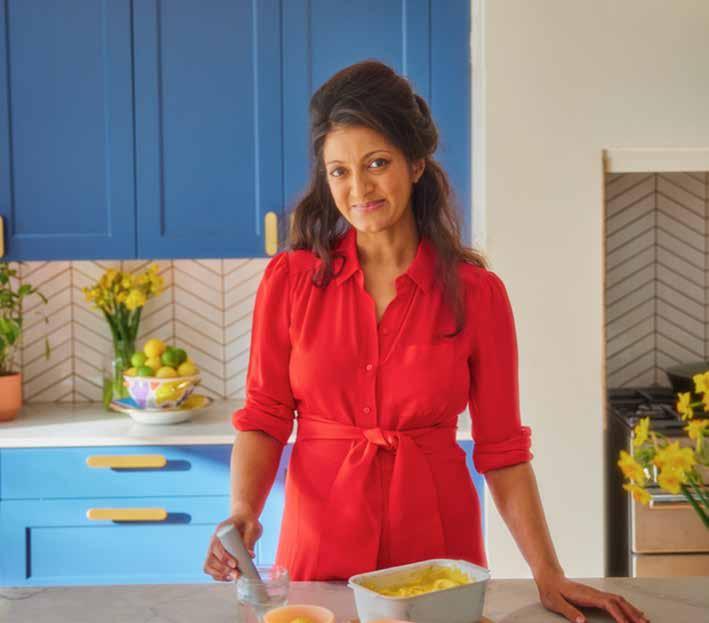
“I think ‘energy saving’ would be the sort of energy that I’ve brought to my books because, as a woman and now, as a new parent, I’m tired all the time. The idea is to get maximum flavour and kudos for your meals in as little time as possible. Hearing from readers that my books have changed the way they cook feels absolutely wonderful. With the new book, it’s amazing that people are cooking and enjoying my family’s take on Bengali or South Indian classics.
My mother is the best cook I know – she can turn her hand to Western cooking just as well as Indian. She’s inspired me to have an open mind and always try out new dishes – we love cooking Italian food at home - cannelloni, zucchini fries, involtini.
As a woman, it feels interesting to be cooking and using the domestic sphere as my workplace – is it unreconstructed of me? But cooking is what I’m best at and I enjoy – and I’m all for the wave of intersectional feminism which says women can do whatever they like.”
India Express by Rukmini Iyer (Square Peg) rukmini-iyer.com
HARRIET MANSELL
Harriet has worked for Mark Hix, at Noma in Copenhagen and on prestigious superyachts. She is now head chef and owner of Robin Wylde in Lyme Regis.

“There are still far more male chefs than female, and I think something we can do to combat this is making hospitality a far more approachable career for everybody.
Working in fine dining is really hard work but we make sure that our employees have a great worklife balance. My staff go out foraging with me and we re constantly learning. We religiously use and celebrate ingredients from our coastline in our dishes. Our seaweed martini uses kelp collected after a spring tide and infused with our gin; we gather sea herbs – like pepper dulse, samphire and saltbush – and from moorland and hedgerow.
As for getting more women into the kitchen, by pure coincidence, at Robin Wylde we are an all-female kitchen. I don’t like to celebrate that, because gender in the kitchen is irrelevant to me. We’re all working hard and will celebrate our achievements as chefs. But I look forward to the day when the ‘best chef’ award in something like The World’s 50 Best goes to a woman.” »
robinwylde.com
67 FINE DINING
MONICA
GALETTI
The Samoan-born chef and former MasterChef: The Professionals judge worked alongside Michel Roux Jr at his two Michelin-starred restaurant Le Gavroche and is now chef proprietor of Mere in London.
“In my kitchen there’s no shortage of women. I employ my team according to skills, attitude and passion, not gender. I became a chef because it’s what I love to do and I had no delusions that it would be tough, physical work. From day one I thrived on the adrenaline of service. If there were more men than women at times, it didn’t bother me.
I have worked in kitchens all over the world –Japan, Barbados, America and Europe – but the best training came from working alongside Michel Roux Jr at Le Gavroche. His words of wisdom are the foundations of where I learnt to cook, respect and appreciate not just the ingredients but nature, the seasons and the suppliers.
The Hokey Pokey Dessert that I developed for Mere is a twist on my favourite treats as a child in New Zealand – Toffee Pops chocolate biscuits and a drink called L&P (Lemon & Paeroa). It’s impossible to take off the menu due to the requests it gets from guests.
To open a restaurant was always something my husband and I wanted to do. As long as we continue to deliver the great food, wine, service and experiences our guests love, that’s good for me for now. I stay at the top of my game by staying true to my values and believing in my team. All women doing their thing in kitchens are killing it; I support them all.”
– Monica Galetti

68
I HAVE WORKED IN KITCHENS ALL OVER THE WORLD... BUT THE BEST TRAINING CAME FROM WORKING ALONGSIDE MICHEL ROUX JR AT LE GAVROCHE
mere-restaurant.com
ROBERTA HALL-MCCARRON
Roberta is the award-winning chef owner of high-end restaurants Eleanore and The Little Chartroom in Edinburgh and is inspired by the very best Scottish produce.


“Kitchens have changed dramatically over the years. They are far more nurturing places now. When I started out it was a pretty aggressive dogeat-dog world, with colleagues shouting at each other and happily letting one another struggle through service. Looking back, it’s a crazy way to operate. I was often the only female in the kitchen but it didn’t really bother me, I never felt like I wasn’t getting the same opportunities as everyone else.
I’ve worked in the Burj Al Arab in Dubai and at Michelin-starred The Kitchin in Scotland. I think anyone at the top of their game in any industry is something to celebrate regardless of gender. You have to make sacrifices and take a lot of knockbacks along the way.
Empowering my team is hugely important to me. No one is allowed to shout in the restaurant, things will go wrong but we fix them and learn from the mistake. I recently had a baby and I haven’t had to worry about the restaurants at all. I am so fortunate to be in that position.”
thelittlechartroom.com
NOOR MURAD
As head chef of the Ottolenghi test kitchen, Noor develops recipes for bestselling cookbooks and restaurant menus and co-authored two books with Yotam Ottlolenghi.
“In the test kitchen my main mission is to provide an inclusive, wonderfully uplifting environment, where the team feel inspired and reach their best potential. As a Bahrain-born chef my culture is very much a part of my identity and I often find myself drawing from my upbringing and the flavours I know and love when dreaming up recipe ideas.
Bahrain is and always will be home to me, so anytime I feel uninspired I just think back to the foods I grew up eating from elaborate rice dishes to cardamom-spiced everything.
I didn’t often see women in leadership roles growing up in Bahrain, especially in hospitality, but I take after my dad who always taught me to put my best foot forward in whatever undertaking I choose. Moving to London, and specifically working at Ottolenghi, I’m constantly in awe of all the powerful women I encounter. Female energy is essential in any kitchen. It’s not to say that one sex is better than the other; all are equally welcome – and necessary.”
69 FINE DINING
OTK Extra Good Things by Yotam Ottolenghi and Noor Murad (Ebury)
CITY OF MUSIC
With the festive period in full swing, Tempus raises the curtain on London best music venues

Words: Gabriel Power
If you had asked the late experimental composer John Cage, he would tell you that everything can technically be classified as music, from Beethoven’s Fifth Symphony to the sound of traffic and urban congestion. After all, where do we draw the line between what is and isn’t music?
But, even if the idea of beeping car horns and bickering commuters doesn’t exactly sound like something you’d sit and listen to, London’s long history of musical excellence – that has spanned everything from high symphonies and music halls, to punk and pop royalty – is still as varied and alive as ever. There are plenty of venues in the capital that have you covered with a host of excellent concerts and gigs this winter, whether you’re into classical or The Clash. Read on for some truly awesome venues raising the bar for musical brilliance… »
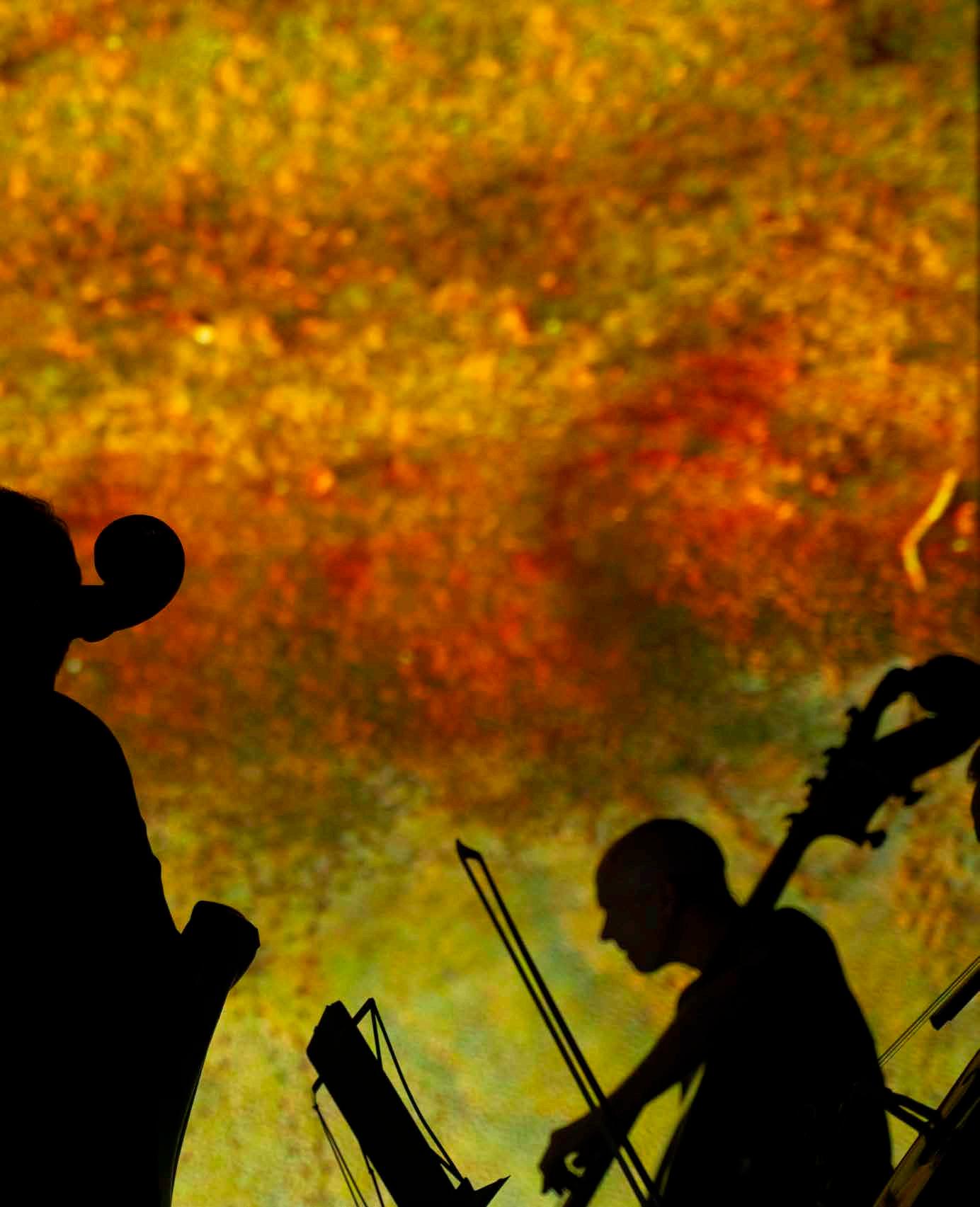
MODERN MUSIC | BARBICAN
One of London’s premier music venues, the Barbican has become known for staging boundary-pushing musical artists from across the world, in an almost eerily well-insulated concert hall seating 1,900 people.

For those looking for something fresh and new, December will see the venue host a unique trio of award-winning British-Bahraini trumpeter Yazz Ahmed, Tunisian avant-garde singer songwriter Emel and legendary Lebanese oudist Rabih Abou-Khalil for an evening of contemporary Arabic music. Meanwhile, on the flip side, 29 December will see the London Concert Orchestra perform a dazzling tribute to the music of Frank Sinatra. There’s something for everyone.
barbican.org.uk
CAMDEN COOL | KOKO
KOKO Camden, one of the most iconic, storied event spaces in London, reopened in April this year after a major refurbishment following a 2019 fire which almost saw the entire building razed to the ground. And its grand reopening once against demonstrated the prestige of the venue as Arcade Fire took to the stage as the inaugural headliner.
And the venue is continuing its trend of pulling in some of the biggest names in popular music. In the 1960s it was the Rolling Stones; in the 1980s it was Prince; in the 2000s it was Amy Winehouse. And in the coming months, artists including Joey Bada$$, Idris Elba and French house sensation Bellaire will grace the stage – keeping KOKO at the cutting-edge of London’s live music scene. »

koko.co.uk

72
London sounds: Australian Chamber Orchestra and Max Richter at the Barbican (previous and main, both © Mark Allen); l-r, The Royal Albert Hall, Union Chapel, Ronnie Scott’s

CLASSICAL SOUL | ROYAL ALBERT HALL
Even if the pomp and circumstance of the BBC Proms doesn’t do it for you, look beyond this annual celebration of classical music to find a host of superb concerts, gigs and shows that are sure to satiate your musical hunger across every possible genre.
Pop-heads should look to spring, which will see artists like John Legend and indie rock icons Death Cab for Cutie fill the auditorium, while film buffs will no doubt already have an eye on 3 June, where the music of score composers John Williams and Hans Zimmer will be celebrated in a night of movie magic.
royalalberthall.com
THE HOME OF JAZZ | RONNIE SCOTT’S
Opened in 1959 in Soho, Ronnie Scott’s is still London’s most iconic jazz club, and with good reason. The venue, founded by the legendary saxophonist who gave the club its name, brings in a mixture of up-and-coming jazz artists alongside some of the genre’s most celebrated performers.

December will see jazz arranger and pianist Luke Smith play a one-off set, as well as a handful of concerts from double BBC Jazz award winner Liane Carroll. Be sure to book well in advance for any concerts at this prestigious venue, however, as shows sell out regularly.
ronniescotts.co.uk
FEEL-GOOD SOUND | UNION CHAPEL
Undeniably one of the capital’s most magical venues, Union Chapel is a force for good both musically and socially. Housed in a Grade-I listed church in Islington, the venue serves as both a visually stunning space for musical performance and a drop-in centre for the homeless of London, providing advice, showers and a laundry service.
In the hushed setting of an 18th-century church, it’s no surprised that folk musicians have long been drawn to Union Chapel, with scheduled gigs from David Gray, Rumer and The Young’uns all coming up in the early months of 2023.
unionchapel.org.uk
HISTORY
73
CULTURE
LONDON’S LONG
OF MUSICAL EXCELLENCE IS STILL AS VARIED AND ALIVE AS EVER
BRITISH LUXURY REVIEW
It was the year that brought us revenge spending, teens splashing out on luxury items and the loss of a champion of British luxury brands. But, as the industry’s response to the Ukraine war and the climate crisis shows, the luxury sector could be forging a new future, pivoting from ‘status’ to ‘purpose’. Here’s our rundown of the year…
Words: Lysanne Currie
74
2022
The cost of living crisis has seen the biggest slump in living standards since the 1950s for many Britons, yet the UK’s luxury sector appears to be relatively immune to the economic downtown, with revenue in the luxury goods market topping £11.35bn ($13.73bn) in 2022 (Statista) and firms reporting bumper profits for everything from designer clothing to expensive watches through to extravagant family holidays.
Although much of this can be explained by ‘revenge spending’ after a gruelling two years of lockdowns and Covid-19 restrictions, the super-rich are instead going for Stella McCartney’s new Frayme
Mylo handbags (made from ‘mushroom leather’ mycelium) or luxury adventure specialists Pelorus noting the rise of “high impact conservation” vacations (think joining a African anti-poaching unit for a week rather than experiencing a conventional safari). It’s clear the industry is experiencing a small but perceptible shift from luxury as ‘status’ to luxury powered by purpose and social responsibility instead.
The key drivers of this trend are arguably the gen-Z and millennial generations, who now account for 72% of the global luxury market, and are demanding sustainability and transparency from luxury brands. These values are also increasingly reflected
in the industry too, most notably the swift decision made by many UK brands to cease operations and trading with Russia following its invasion of Ukraine in February 2022, a move which has cost many companies millions.
The sector is still beset with challenges, with the 2020 abolition of the tax-free shopping scheme hitting UK retailers. Meanwhile, the UK luxury sector lost arguably its biggest totem when Queen Elizabeth II passed away in September. From the highs to the lows, we look at the trends that have shaped the previous 12 months and gaze into our crystal ball to see what 2023 might offer… »

75
GLOBAL AND UK RECOVERY: LUXURY IS BACK
There is now a record 610,000 people classed as ultra high net worth individuals (UHNWI) –with assets of more than $30m/£22.4m – around the world, an increase of 9.3% since last year, according to property consultants Knight Frank. In the UK, these UHNWIs have doubled since 2016 and now number 25,771 (UK prime minister Rishi Sunak is also a UHNWI, whose combined fortune with wife Akshata Murty is £730m).










They’ve been spending this wealth too: the global luxury industry is projected to reach €1.4trn (£1.2trn) in sales revenue this year, up 21% from 2021 according to a report from Bain & Co/Altagamma. As a result, the balance sheets of many luxury goods corporations are in excellent shape. The Q3 sales for LVMH (the world’s largest luxury goods company which owns Christian Dior, Stella McCartney and TAG Heuer watches) climbed 19%; Hermès and Kering (owner of Gucci and Balenciaga) recorded increases of 32.5% and 14% over the same period. The UK’s luxury goods market is equally as buoyant, worth $13.73bn/£11.35bn, and with even Amazon appearing to have its eyes on the sector, launching its Luxury Stores division in June.
The annual contribution the luxury sector makes to the UK economy

By 2025, it’s estimated online sales will be the single biggest channel for personal luxury goods, making up


£48bn 30%
of the global market
















FOR EVERY €1 SPENT BY A TOURIST IN EUROPE, A HIGH-END TOURIST SPENDS AROUND 8 TIMES MORE
THE RISE OF ‘REVENGE SPENDING’
An estimated £140bn was saved by UK households during the pandemic, according to the Office of National Statistics. 2022 was the year when many seemed eager to spend these funds, forking out on weddings, socialising and holidays missed during lockdowns (plus clothing for these events). This boom for ‘revenge spending’ was seen most markedly in the luxury sector, with one industry expert from Moët Hennessy hailing it as the start of the “new roaring 20s”. Despite the recession, there has also been a demand for mood-bosting small luxuries, leading some to speculate that the lipstick index – Leonard Lauder’s notion that sales of affordable luxuries rise during economic downtowns – has returned.
76
summer 2022, a cask of scotch whisky was bought for a record £16m by a private collector. The single malt, known as Cask No 3,
1975 and was produced
Ardberg distillery
Scottish island
Islay
In
dates from
by
on the
of
GEN Z SPLASH OUT
The future of the luxury goods market appears to be in rude health, largely thanks to millennial and Gen Z consumers. These age groups, which are defined by their YOLO (“You Only Live Once”) attitude and conspicuous consumption on social media such as Instagram and TikTok, now account for 72% of the global luxury market, according to management consultancy Bain & Co. Gen Z-ers, those largely mortgage-free youngsters born between 1997 and 2012 – are now purchasing luxury items at around age 15, around three-five years earlier than their millennial forebears. As such, Bain & Co predicts this generation will comprise a third of the luxury goods market by 2030.
CHALLENGES FOR BRITISH LUXURY
The British luxury sector has expressed concern that the decision to scrap the VAT Retail Export Scheme in 2020 (a scheme which saw non-EU tourists reclaim 20% VAT paid on their purchases) risks tarnishing the UK’s calibre as a luxury shopping destination, with many luxury shoppers heading to the boutiques of Paris and Milan instead. It’s been predicted the scheme’s termination could lose as much as £680m in tax revenue, as well as put 41,000 jobs at risk.
Meanwhile, Covid-19 restrictions in China has been unwelcome news for those UK luxury brands favoured by the country’s tourists, which were the world’s top tourism spenders prior to the pandemic ($254.6bn (£195m in 2019). China’s Covid-19 restrictions also caused supply chain headaches for many brands in 2022.
MOST POPULAR LUXURY BRANDS IN THE UK 2022
SALES ARE UP FOR…
















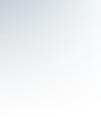

WATCHES
The UK luxury watch market was worth £1.41bn in 2022 and is expected to grow by 5.98% in 2023
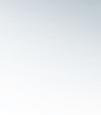

SUPERCARS
More than 18,000 supercars – including Aston Martin and Ferrari – were registered at UK addresses last year, a 19% increase from 2020. The City of Westminster (which includes Mayfair and Knightsbridge) is the UK’s supercar capital, home to 553 supercars
LEATHER
Revenue from luxury leather goods was £2.21bn in 2022. The market is expected to grow 7.46% next year
LUXURY WITH A CONSCIENCE
The socially-conscious values of Gen Z are also being mirrored by luxury brands, who are now increasingly sharing public statements on environmental and social issues, whether it’s pledging to cut carbon footprints or taking a stance on human rights. Nowhere was this more starkly illustrated in 2022 than when brands such as Burberry and Aston Martin made the sudden decision to stop sales to Russia following Putin’s invasion of Ukraine. By preventing oligarchs from purchasing their designer handbags or supercars, many firms lost millions (UK companies sold £2.6bn of goods to Russia in 2021), but the alternative – being a pariah business blacklisted by consumers –would have been worse.
NEW YEAR’S TRENDS
A recent report by Bain & Co and Italian luxury goods trade body Altagamma forecasts that the global luxury market will be even more “recession-proof” in 2023 than during the 2008/09 financial crisis. In particular, conditions look rosy for the personal goods market, which is forecast to show accelerated growth of 22% to €353bn.
Sources: Statista.com, YouGov.co.uk, Office of National Statistics, Bain & Co/Altagamma



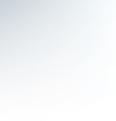

77
Dior Ralph Lauren Cartier Swarovski
Hugo Boss Chanel
Yves St Laurent Rolex
Ending VAT refunds on shopping could cost the UK £680m in tax revenue and 41,000 jobs
ISLAND JEWEL
Experience barefoot luxury in serious style as Bulgari Hotels Bali merges Italian flare with Indonesian spirit
Words: Stephanie Gavan
There are few places that live up to their name quite like Bali; the Indonesian ‘Island of Gods’, where magic looms around every picturesque turn. Not least in the island’s southernmost tip, Uluwatu – literally translated as ‘lands end’ – where the threshold to the transcendental thins out amid cliff-hanging drama and knee-weakening sunsets. Paradise,
you could say. But it wasn’t so long ago that this particular paradise, thanks to a succession of lockdowns and strict travel restrictions, saw its usual flock of Eden-seekers down to double digits – in 2021, in fact, the island received a mere 45 international visitors. Thankfully this year the gods have relented and Bali is back in business. But for now, let’s rewind. »


It’s just past 7pm and I’m pulling up to the Bulgari Resort Bali, where I’m greeted by an impressive arrival pavilion, a much needed post-flight tonic of mint, basil and honey and what feels like a embrace from an old friend. “Hospitality is in the heart and soul of Balinese people,” Anthony Smekens, Bulgari Hotels & Resorts general manager tells me.
Opened in 2006, the resort is spread across 21 tropical acres on the island’s Bukit peninsula. Once the hunting grounds of the Balinese royal families, these days the area remains one of Bali’s best kept secrets, with a smattering of exclusive properties, knock-out temples and some of the world’s finest surfing locations – all suitably far from the madding crowd.
With the Bulgari resorts famed for their style, Bali’s villas do not disappoint. Cut from local volcanic stone and perched up to 160m above sea level, all 59 of them are tropically triumphant; think intricately hand-carved doors, bamboo roofs and sultry interiors of rich, mahogany wood.

Inside, Balinese antiques and locally sourced embroidered fabrics sit beside hefty Bulgari coffeetable books, while outside an intimately contained open-air living space makes a fine spot for al-fresco dining and sun-drenched reclining. From my private plunge pool, I watch the evening sun bruise the sky in brilliant shades of pink and it suddenly seems obvious why Bulgari – a brand known for its colourful flights of fancy – should set up shop here; the pair make rather bedazzling bedfellows whose gem-toned thrills cannot be understated.
NATURE’S GEMS
Natural jewels aside, the pace of life here is gratifyingly slow. After a crack-of-dawn guided yoga session, I head to sea-facing Sangkar, Bulgari’s Indonesian fusion restaurant, where all my good intentions are immediately undone as I work through a heaped plate of nasi goreng (okay, and maybe also a pastry or two) while watching a monkey nonchalantly rummage through the sacred offerings left on an obelisk outside.
Vestiges like these can be found sprinkled throughout the resort, speaking to the deeply spiritual Balinese culture. “Nowadays,” Anthony continues, “our guests are looking to participate in local discoveries and cultural activities”. It’s a trend that can be seen across the luxury travel industry, where travellers are tending toward experiences that foster meaningful connections and can’t be found in a guidebook.
One such experience on offer here is the Melukat purifying ceremony, which can be arranged at the temple of the resort or the beach. On a mission to conquer my unrelenting fear of heights, I choose the beach, accessible by a dizzying cliffside funicular. The next hour is an incense-induced haze as a Hindu priest from the neighbouring village chants, intermittently casting flowers into the waves that crash in succession before foaming their way across bone-white sand. Multiple blessings later, I feel sufficiently absolved and, dare I say, ready for whatever vertigo-inducing adventure life springs on me next.

»
Island style: Relax by private villa pools (top left) or the cliff-side pool (left); The Bar (above); Sangkar Restaurant (right)

80


Spoiler: it was a helicopter trip to the royal passage of Klungkung, one of Bali’s most important historical and cultural attractions. For those more partial to earthbound excursions, verdant Ubud is home to scenic rice paddies, mischievous monkeys and artisan homeware stores selling everything from bamboo baskets to handmade ceramics. Closer to home, Uluwatu Temple in Pecatu is considered one of the island’s six spiritual pillars. Head there for daily sunset Kecak performances – a traditional fire dance that tells the story of Ramayana, a Sanskrit epic, in the most dramatic, nay, bewitching way.
INDONESIAN INDULGENCE
Back at the resort, Michelin-starred chef Luca Fantin is preparing for dinner. In contrast to the hotel’s more casual La Spiaggia, which specialises in fresh, grilled seafood, Fantin’s eponymous restaurant is a woo-worthy set up of white linens and candlelight. Tonight’s liberal seven-courser consists of dishes like chargrilled beef with caperfilled aubergine alongside more experimental plates of cold spaghetti and caviar, putting an Asian spin on traditional Italian fare. All paired expertly with wines from the restaurant’s 200-bottle collection.
Having overdone it ever-so-slightly on an Umbrian vintage, the next morning I swing by the gym where views of the garden from floor-to-ceiling windows make the usual treadmill grind that little bit easier. For guests more devoted than I, a team of expert trainers are at hand to devise bespoke nutrition and exercise regimes throughout their stay. Then it’s off to the spa – though to call it such risks underplaying this monument to relaxation. It’s fair to say that Bulgari doesn’t do things by halves, evinced most profoundly by the building which houses said spa – an antique joglo highroofed wooden building painstakingly dismantled in central Java and reassembled on site. The
muscle-melting Balinese massage works a dream, quite literally. I wake up feeling reborn, and, with my mind emptied of its usual neurotic flurry, enjoy a rare moment of uninterrupted nothingness as I gaze out across the ocean, tea in hand, from the adjacent relaxation area.
After a dip in the main pool – a must for the Instagram-inclined, as the infinity edge blurs into the sky – an aperitivo is in order; Il Bar has all the brooding brilliance of an Italian runway set. It’s no coincidence, then, that the design of the black resin ellipse arch bar was plucked straight from Bulgari’s Milanese outpost. Likewise, the signature cocktail made with gin, Aperol, orange, lime and pineapple is a staple among all seven hotels – currently Bali, Milan, London, Dubai, Beijing, Shanghai and Paris, with further locations in Miami Beach, Ranfushi and LA opening in 2026. Next year will see hotels open in Tokyo as well as a new flagship property in the brand’s Roman homeland.
Andy Warhol once dubbed the jeweller’s Eternal City headquarters the most important museum of contemporary art and, frankly, the same could be said about their resorts, where fine-tuned craftsmanship – courtesy of the Bulgari Group’s go-to architects Antonio Citterio Patricia Viel –outstrips nearly anything you’ll find at Frieze.
Having just returned from Bulgari Dubai, home to two Michelin-starred restaurants, a 46-boat harbour and one of the world’s best 50 bars, one thing the brand excels at is capturing the genius loci of each place – the immaterial essence that cannot be rationally explained – all the while maintaining that unmistakable Italian flair.
In Dubai, it’s high-voltage luxury; in Bali, barefoot utopia. But what unites them is a dedication to artistry and an intimate understanding that, just like crafting a jewel, you must start with the right stone.
bulgarihotels.com



82
TRAVEL


 Luxury unlocked: The Bulgari Villa (below),; villa and spa interiors (left)
Luxury unlocked: The Bulgari Villa (below),; villa and spa interiors (left)
OCEAN DRIVE
We put Bentley’s new extra long Bentayga through it paces along America’s Pacific Coast
 Words: Rory FH Smith
Words: Rory FH Smith
It’s 7:00 am and already the sun is pounding down on The Peninsula Beverly Hills’ rooftop. Sitting three floors below me is a brand-new Bentley Bentayga Extended Wheelbase, ready to hit the road for a 320-mile road trip up the Pacific Coast Highway to Monterey.
In LA, there’s no shortage of fast and expensive automobiles. The sprawling city, which is home to nearly four million people across 502 square miles, is the world’s capital for celebrity culture, fame and fortune. Founded in 1781, LA is the place where the rich and famous come to showcase their wealth and standing – while the remaining 99.9% are busy trying to get there. As far as four-wheeled fame goes, nothing signals success quite like riding in the back of your own car – something Bentley’s latest model, the lengthened Bentayga, was born for.
Already a pleasant place from which to watch the world go by, the standard Bentayga wasn’t exactly lacking in luxury; but the latest lengthened version adds 180mm to the wheelbase in the pursuit of back-seat perfection. While a few millimetres might seem trivial in a car that measures nearly 5.5m in length, it makes all the difference to those riding in the back seats, which all becomes apparent as I climb up into it.
As the Peninsula’s valet wishes me well
and closes the Bentayga’s door, I find myself ensconced in one of the most sumptuous interiors to come from the Crewe-based car maker. Like the rest of the Bentley fleet, the interior build quality, materials and overall feel are second to none.
A seemingly unlimited number – 24bn, to be precise – of different trim combinations can be selected from Bentley’s range of wood veneers, metals and leather. But it’s the optional airline seat specification that sets the longer Bentayga apart from its peers, including a nifty climatesensing, auto-adjusting seat that adapts the temperature to apply heat, ventilation or both to keep the passengers at just the right temperature. For those who just can’t get comfortable on a long drive, the boffins at Bentley have built in an auto-adjustment system that changes the seat position or applies pressure to keep you as relaxed as possible.
Of course, all that comfort comes at a price – £8,395, for the airline seat option to be exact. While that’s a drop in the ocean compared to the car’s price of £211,300 for the Azure edition Bentayga Extended Wheelbase, it’s easy to see the value when you’re reclined and wafting down California’s oh-so-pretty Pacific Coast line at pace. »
84




86
Cruising along, we take a break at the Rosewood Miramar Beach club outside Santa Barbara on the oceanfront stretch of Montecito, known as The American Riviera. The smart, white-painted neoclassical beach club is an exclusive seaside retreat for those looking to escape the bustle of LA. Stopping for lunch, it’s not long until we’re back on the road, heading north on Route 101 again but this time behind the wheel of the elongated Bentayga.
Venturing off the highway and up some of the twisting canyon roads, you’d be forgiven for thinking a 5m-long car would struggle in the bends but the longer Bentayga takes the turns in its stride. With Bentley’s 542bhp twin-turbo V8 up front, the performance is effortless, while trick electronic stability systems keep the body roll under control. In tight bends and city streets, the new rear-wheel system kicks in to help bring the back around, meaning the longer Bentagya is surprisingly agile given its dimensions.
Leaving the heat and permanent sunshine of LA in our rear-view mirror, we hit the swooping section of Route 1 through the Big Sur state park. This stretch of road along California’s
rugged, central coast between San Luis Obispo and Monterey is best-known for its rolling sea mist, winding turns through coniferous forests and towering seaside cliffs. Weaving our way through this national treasure trove of unspoilt and undeveloped coastline is a treat after hammering down sections of interstate and it’s not long until the familiar sight of the soaring Bixby Creek Bridge comes into view on approach to Monterey.
First opened in 1932, this graceful arch is one of the most iconic landmarks on America’s Pacific Coast, with its elegant architecture and its magnificent setting marking the end of a largely deserted section through Big Sur.
Crossing over it, it’s not long until we return to the comparatively built-up towns of Carmel-bythe-Sea and along the slow coastal road, lined with large holiday homes and golf resorts to reach Monterey, our final destination.
Ticking off one of the greatest driving roads in the world is always a satisfying feeling, made even more so when paired with a well-matched motorcar. For most of the road-trippers down California’s Pacific Coast Road, the ideal steed

is something American and topless – think Ford Mustang, Dodge Charger and maybe even an original, split-screen VW bus for those seeking the surf. But, unashamedly British, the Bentley Bentayga Extended Wheelbase proves to be the ideal tool for the job with its mix of sumptuous comfort for the long motorway slogs, while the burly powerplant up front makes for a spirited drive when the going gets twisty.
Arriving at our final stop in Monterey, as the afternoon sun starts to melt into the Pacific sea mist, it’s unusual to feel refreshed after a two-day drive. However, comfort, as well as performance, is something that Bentley has perfected in more than 100 years with the manufacture of powerful grand tourers; its latest car applies that formula to the marque’s best-seller SUV, resulting in a potent mix of comfort, luxury and driving character.
While that rich mix continues to be Bentley’s secret to success, experiencing it out on one of the world’s greatest driving roads is a bucket-list box well worth ticking.
M OTORING
bentleymotors.com
Englishman in LA: The Bentley Bentayga turns heads on a Pacific Coast trip from Los Angeles
PAST, PRESENT AND FUTURE
Vacheron Constantin’s Christian Selmoni on how the brand’s heritage is changing modern watchmaking
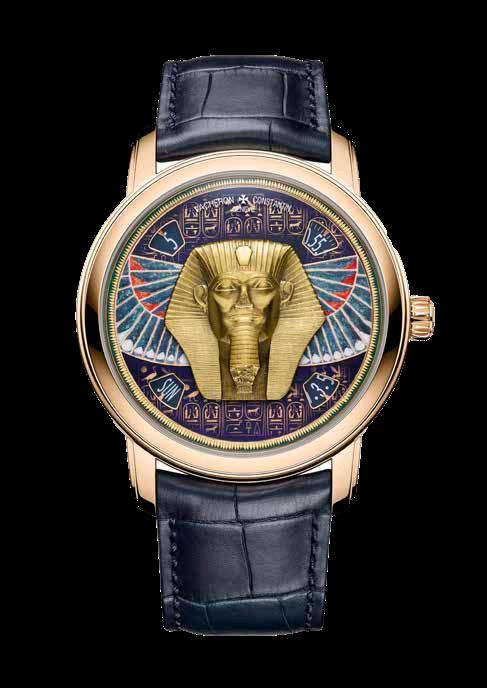
 Words: Michelle Johnson
Words: Michelle Johnson
When it comes to incorporating unmatched history and heritage into bold new product designs, Swiss watchmaker Vacheron Constantin has a secret weapon: Christian Selmoni (pictured). The brand’s style and heritage director joined the company in 1990 and in the past 33 years has risen the ranks from sales administration manager and then purchasing manager to production and purchasing director, before moving into product development and building a new project department from the ground up in 2001.
“Our most important challenge was the development of the company’s 250th anniversary timepieces,” says Christian of the department, which began as a modest fourperson team. “By 2005 I was appointed product marketing director until, in 2010, I asked my bosses whether it would be possible to dedicate myself to product strategy and design – all the creative aspects of Vacheron Constantin.”
Christian got his wish, serving as the brand’s artistic director until he was appointed to his current position in 2017. As style and heritage director, Christian is the keeper of the keys to Vacheron Constantin’s fabled archives – from unique creations for famous clients to vintage complications from the brand’s 267-year history – as well as bringing new ideas to the table.
The brand itself is known in equal parts for its technical brilliance and artistic flair. This year alone has seen such varied novelties as a pink gold version of the sports classic Overseas chronograph, four Métiers d’Art timepieces – the Grand sphinx de Tanis (right), Lion de Darius, Buste d’Auguste and Victoire de Samothrace –in collaboration with The Louvre; and several bejewelled ladies’ Égérie moon phases. Here, Christian shares his favourite watchmaking trends, discoveries from the archive, and how the brand’s heritage has become a starting point for innovation. »
88
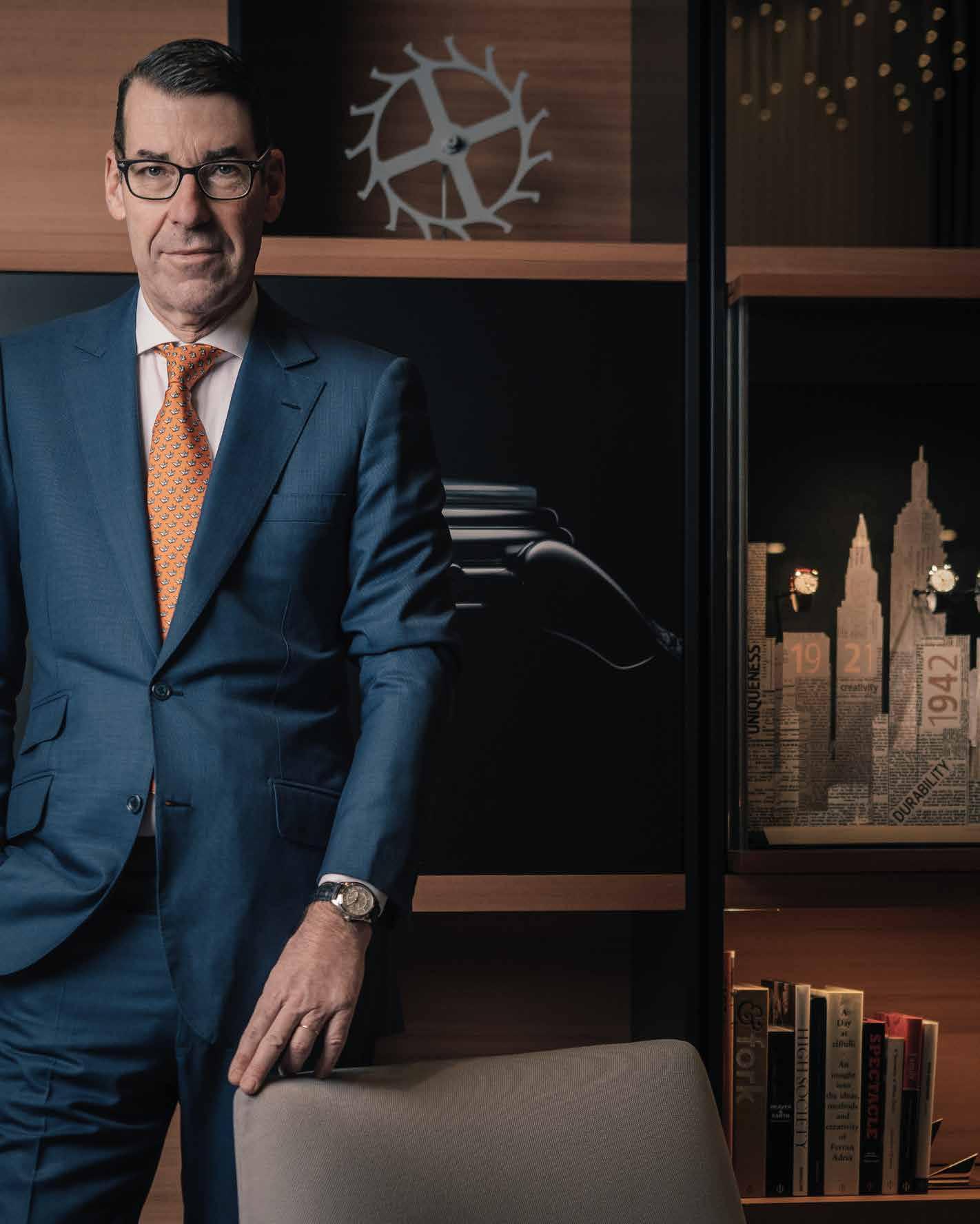
Christian,
I focus on two activities. The first is product; I’m a member of Vacheron Constantin’s Product Committee, bringing new ideas and concepts while keying into the great heritage of the company to support our future style. Then, the heritage aspect of my role has been my mission since 2017. I want to put a spotlight on the great heritage and legacy of Vacheron Constantin, and communicate our history, stories, timepieces and more. I really enjoy this job; it’s absolutely fascinating and there are endless discoveries of new stories and products to be made.
Could you tell us about some of the discoveries that have inspired you?
In 2017 when I took over the Heritage Department, I naïvely thought I had quite a good knowledge of our legacy timepieces. But, the first time I went to a collectors’ convention, I was speaking to a friend who had a simple, whitegold Vacheron Constantin timepiece on his wrist, which I had never seen before. He told me it was the reference 3570 – only eight of which had ever been made.
I started to understand that heritage isn’t just having a good knowledge of watches from the past, but about understanding the stories and history behind these watches. The true treasure of Vacheron Constantin is our archives. A few months ago, I found records of a huge tourbillon pocket watch that had been created for the Maharaja Sir Bhupinder Singh of Patiala; a similar timepiece was made for Henry Graves Jr – maybe the most famous watch collector from the first half of the 20th century.
Perhaps one of the most unique examples of how your heritage impacts today’s novelties is in your Les Cabinotiers collections. Could you tell us more?
In the beginning of the 20th century, we were well known for our bespoke timepieces. We created Les Cabinotiers to give our clients a new opportunity to create the watches of their dreams. These watches can be very complicated, or feature wonderful decorative crafts such as miniature painting, enamel or engraving. It was a very ambitious concept because, as you can imagine, you need a lot of manpower and creative partners. I have no better example of what Les Cabinotiers can achieve than a pocket watch presented last year: Les Cabinotiers Westminster Sonnerie – Tribute to Johannes Vermeer. It’s a very complicated chiming watch decorated with miniature painted enamel by the
famous artisan Anita Porchet, which took eight years to complete.
Is it important for you to work with specialists like Anita Porchet?
If we look back to the early years of Vacheron Constantin, we produced very complicated watchmaking – chiming watches or astronomical timepieces – of a very high level of execution. But the interesting thing is that we are also specialised in decorated watches. This is really our specialty, this combination of very high watchmaking combined with decorative crafts. We have been using four historical decorative crafts – enamelling, engraving, hand guilloché and gemsetting, which are in-house specialties –since the 18th century and are committed to the preservation and development of these crafts.
How do you plan to develop these historic crafts?
The challenge here is something we also consider in technical watchmaking. The idea is not to simply pay tribute to the crafts of the past – we don't want to replicate crafts or subjects from the past – but to express our creativity, and the talent of our artisans, by anchoring these traditional crafts in the 21st century. For example, hand guilloché was used to be featured mainly on the covers of pocket watches as geometrical decoration, but our Master guillocheur has created a figurative pattern using the same technique. He is extremely talented; if we were in Japan he would be considered a living treasure. It’s a perfect example of how you can still innovate and create something new within this great traditional life.
Tell us about the maison’s Les Collectionneurs initiative?
The concept is that we are acquiring vintage Vacheron Constantin pieces, from auction, merchants, or clients, to restore in our workshop, before offering them for sale with a two-year guarantee and certificate of authenticity. We were the very first Maison brand to do this and there has been a lot of demand. It’s great to be able to offer watches – some that are more than 100 years old – that are still performing super well.
What current trends are you seeing from your clients?
In terms of current trends, vintage is really very important. Last year we celebrated the 100th anniversary of the American 1921 – probably one of the very first driver's watches – with two new versions. But we also made a completely unique
reconstruction of the original American 1921, a watch which has mobilised the remarkable expertises of the maison’s restoration workshop and Heritage department for an entire year. This approach is reflecting Vacheron Constantin’s commitment to the conservation, transmission and continuous enrichment of its heritage and of traditional skills.
Secondly – it won’t be a surprise, I’m sure –we are seeing a great interest for steel watches on steel bracelets. This is an area in which our watchmaking style is extremely successful. We can have beautiful, high-end watches with grand complications, but that can be worn every day, in any circumstance, thanks to these very solid and robust steel cases and bracelets. One example is our Overseas collection, which is very successful.
What do you think we can expect for the future of Vacheron Constantin?
I would say Vacheron Constantin is one of the benchmarks in high-end, classic timepieces. We have several design expressions, from the Overseas sports watch to the classic Patrimony or Traditionnelle collections, as well as metal watches, historical watches and ladies’ watches. Our aim is really to carry on with building our portfolio and respect the balance between our collections. We are also developing our releases in line with the evolution of our society, by presenting new models all along the year instead of only at fairs like Watches & Wonders once a year. Digitalisation and social media have become very influential, and it’s important to be ever-present to be able to speak to our clients more easily.
vacheron-constantin.com

90
what does your role as style and heritage director entail?
WE DON'T WANT TO REPLICATE THE PAST, BUT EXPRESS OUR CREATIVITY – AND THE TALENT OF OUR ARTISANS – BY ANCHORING TRADITIONAL CRAFTS IN THE 21ST CENTURY
Timeless style: Vacheron Constantin Overseas chronograph in 18k pink gold (main); ladies' Égérie moon phase jewellery (inset) featuring 845 diamonds in the dial and case alone

BEST OF BRITISH
The great and good of the luxury industry gathered at The Dorchester Hotel on 21 November to celebrate the Walpole British Luxury Awards, hosted by Top Boy and Moon Knight actress Saffron Hocking. The awards, created by the UK’s official body for the luxury sector, honoured outstanding crafts and companies within 10 categories, including made in the UK, creative collaboration, luxury innovation, sustainable luxury brand of the year and british luxury brand of the year.
400 industry creatives, executives and influencers attended the ceremony, with big name guests including Amber Le Bon, Amy
Jackson, Eric Underwood, Sharifa Butterfly, Oliver Proudlock and Miquita Oliver.
Walpole’s mission to promote and develop the British luxury sector began in 1992, and it now counts more than 250 brands as members as well as being recognised in both Westminster and Brussels. The £48bn sector creates 15,000 jobs in the UK and, says Walpole, is destined to become a world leader in sustainability.
“This year we received a record number of nominations from British brands at the forefront of innovation, craftmanship, hospitality, design and sustainability, who positively contribute to the evolving economic and cultural impact of

British luxury globally,” said Helen Brocklebank, Walpole CEO. “Not only do this year’s winners stand out for their exceptional products and services, but they are notable for their investment in the UK, local economies, employment, arts, and culture which is exactly what this country needs from business right now.”
Walpole also founded its Brands of Tomorrow programme in 2007 to develop and nurture emerging luxury brands and has, so far, taken more than 135 companies through its 12-month programme of networking and mentorship. Here, we meet the biggest names in British luxury – as well as the sector's future stars…
Celebrating the most outstanding brands in the luxury sector with Walpole's British Luxury Awards
3
1. BRITISH LUXURY BRAND OF THE YEAR | GLENEAGLES

This five-star hotel, spa and golf club in Perth, Scotland, has been a jewel in the UK’s crown since it opened in 1926. Known as the ‘Palace in the Glen’, Gleneagles has completed a six-year plan to “reinvigorate the spirit of glamour and adventure” that first put it on the map. (Below left, Gleneagles’ John Barclay and Conor O’Leary with Walpole’s Helen Brocklebank). gleneagles.com
2. CULTURAL CONTRIBUTION | CHANEL
Founded by French fashion icon Coco Chanel, Chanel is an international powerhouse in the world of fashion, make up, perfume and accessories. Last year, the brand’s global head of arts and culture, Yana Peel (left), founded the Chanel Culture Fund, which supports innovators across the arts in advancing new ideas, broader representation and collaboration. chanel.com

3. LUXURY INNOVATION | THE MACALLAN
For exceptional Single Malt Whisky, look no further than The Macallan. With a range of collections to titillate the senses of any connoisseur, the Speyside distillers were recognised for their unique collaboration with Bentley Motors. The two brands launched a limited edition single malt, The Macallan Horizon (opposite), to celebrate their partnership, available 2023. themacallan.com
4. GREAT CREATIVE BRITONS | MICHAEL G WILSON & BARBARA BROCCOLI, THOMAS HEATHERWICK
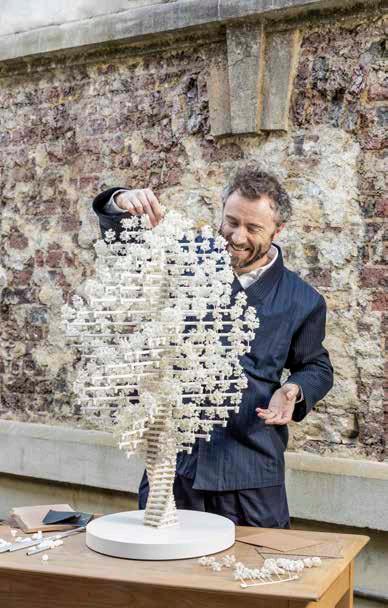
This award was presented to three creatives who, the organisation says, “enrich the luxury landscape in the UK”. Barbara Broccoli and Michael G Wilson, producers of the James Bond films, hosted a range of charitable activations through 2022 to celebrate 007’s 60th anniversary, while Thomas Heatherwick (below) was awarded for his The Tree of Trees installation for the Queen’s Platinum Jubilee. eon.co.uk; heatherwick.com
5. MADE IN THE UK | HARRIS TWEED HEBRIDES
Harris Tweed Hebrides (below, for AllSaints) is a name synonymous with this fine fabric; in fact, the fabric and production method are safeguarded by an Act of Parliament. Unmatched traditional craftsmanship and quality go into every weave, while the brand is also undertaking an impressive rural sustainability initiatives to ensure the future is bright. » harristweedhebrides.com
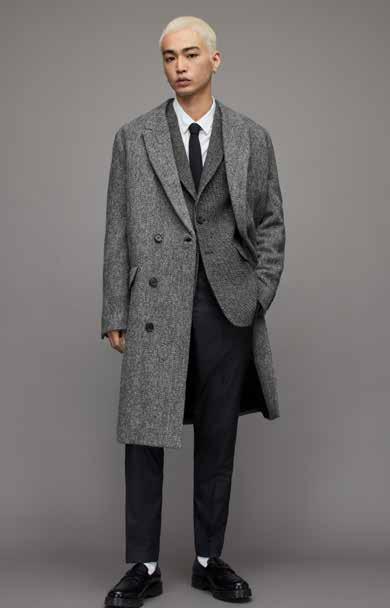
2 1 4 5 LUXURY
6. SUSTAINABLE LUXURY BRAND OF THE YEAR | MULBERRY
Mulberry’s Made to Last Manifesto showcased its ongoing commitment to transforming the fashion brand’s entire production method into a regenerative and circular model. The seriously impressive pledge will see Mulberry (right) achieve a circular model by 2030 and become NetZero by 2035. mulberry.com
7. CREATIVE COLLABORATION | FORTNUM & MASON X THE GREAT BRITISH PUBLIC FOR THE PLATINUM PUDDING
Fortnum & Mason launched the Platinum Pudding Campaign, inviting the public to create a brand new pudding to mark The Queen’s historic jubilee. The competition was open to anyone over the age of eight and supported by the Royal Household (and the Queen Consort Camilla, below). fortnumandmason.com
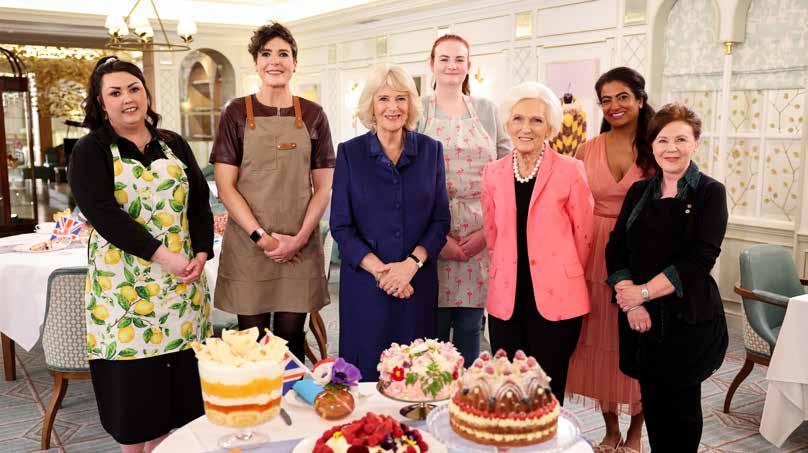
8. VISIONARY | EDWARD SEXTON
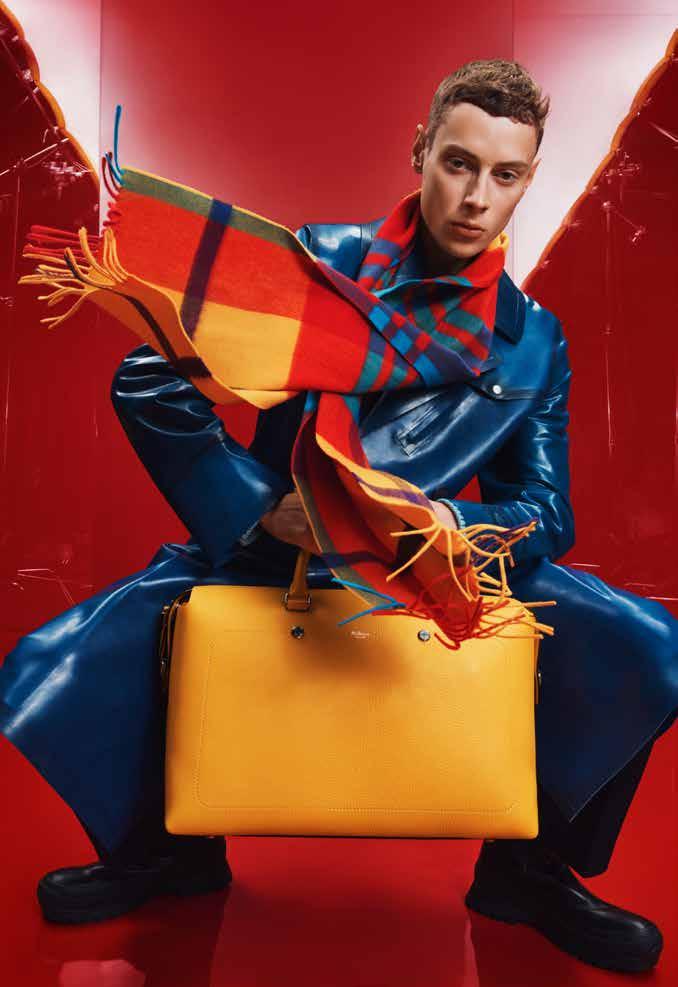
Savile Row tailor Edward Sexton (below right) surely needs no introduction. A key player in the history of British tailoring, his famous clients have included Cary Grant, Annie Lennox, John Lennon, Mark Ronson, Harry Styles, as well as mentoring fashion’s biggest stars, including Stella McCartney. edwardsexton.co.uk

9. LUXURY STORYTELLER | BRITISH PULLMAN, A BELMOND TRAIN X WES ANDERSON
Who wouldn’t want to spend a day in a Wes Anderson film? British Pullman, A Belmond Train, made that possible with a visionary – and visual – collaboration that reimagined the train journey in cinematic style (bottom). From pastel pink ceiling to green carpets and chairs, wooden panels constrasting with bold, sharp lines, this is a travel must. belmond.com

6 7 9 8








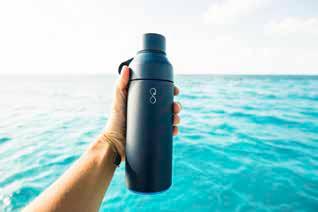



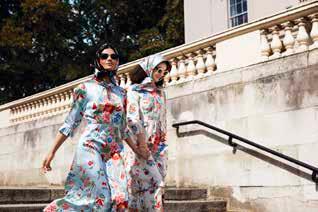
95 1. Circle of Style Luxury pre-owned fashion, handpicked for you by a personal stylist circleofstyle.com 2. Decree A succinct, doctor-led skincare range created by Dr AJ Sturnham thedecree.com 3. Feldspar Sophisticated tableware designed by Jeremy and Cath Brown feldspar.studio 4. Lauren Dickinson Clarke Scented candles and home accessories celebrating the muses, misfits and rebels laurendickinsonclarke.com 5. Luxury Promise Buy, sell and exchange pre-loved luxury goods with clever community shopping luxurypromise.com 6. LIHA Beauty These skincare products based in Yoruba (Nigerian) tradition encourage self-care lihabeauty.com 7. Marion Ayonote Contemporary footwear design with Venetian craftsmanship in its sole ayonote.com 8. Ocean Bottle A brand on a mission to create the world’s most sustainable and practical reusable bottle oceanbottle.co 9. Petit Pli These innovative and stylish garments grow with baby for adaptable and sustainable style petitpli.com 10. Savin London Luxury bridal and eveningwear brand making waves for its romantic designs savinlondon.com 11. With Nothing Underneath Woman’s search for the perfect shirt is over thanks to WNU’s statement tailoring withnothingunderneath.com 12. YOLKE Silk sleep and homeware combining bold prints and contemporary shapes yolke.co.uk ONES TO WATCH Introducing the 2023 Brands of Tomorrow 1 3 5 7 9 11 2 4 6 8 10 12
RESHAPING CAPITALISM
How can profit and purpose work together to create a better, fairer society and a healthier planet? We meet the influential names wanting to move to a kinder form of capitalism

96
Words: Lysanne Currie
With social inequality becoming an ever widening gap, many are beginning to wonder whether capitalism as a working model isn’t currently fit for purpose. Cue a new generation of HNW individuals moving away from conspicuous consumption and using their wealth and experience as a force for good.

Ella’s Kitchen founder Paul Lindley OBE (above) is one of a growing number of HNWs who believe we need to reshape capitalism for the good of society and the planet. Paul founded the UK’s biggest baby food brand in 2006. It became one of the country’s first certified B-Corporations before he sold it in 2013 for more than $100m. These days he actively uses
his entrepreneurial mindset for purpose-led ventures, including in his role as chair of Robert F Kennedy Human Rights UK.
Interestingly, Paul does think the idea of capitalism is sound. “[Capitalism has] created prosperity over two or three centuries and lifted millions of people out of poverty," he says.
"It’s been the driving force behind innovation and served society really well. It’s seen off other alternatives to ways we could run an economy – communism and fascism, for example – in the 20th century… And it’s all we’ve got.”
If you sense there’s a ‘But’ coming, you’d be right. “Capitalism isn’t working at the moment, and it’s increasing inequality,” he says. “I think there’s a whole raft of things that make it
inappropriate to continue as it is. Austerity, the [Covid-19] pandemic, the Climate Crisis, the cost of living crisis and the financial crash have really made it difficult for investors to invest, and for businesses to innovate, because it’s so uncertain what the future is and what the returns will be. On top of that, the inequality we’re creating is unsustainable for a peaceful and a successful society.”
Numerous CEOs are making similar noises, such as US billionaire Marc Benioff, who told the 2020 World Economic Forum at Davos: “Capitalism as we have known it is dead… This obsession we have with maximising profits for shareholders has led to incredible inequality and a planetary emergency.” Likewise, Angela Merkel, Germany’s former Chancellor, said: “The whole way we do business… will have to be changed. In the next 30 years, we have to come to completely new value chains.”
Management consultant Ben Gallagher, founder of business consultancy, B+A, concurs: “All the stuff we’ve been judging our success in life by are the wrong markers. We need markers of success that are more oriented towards caring for people and communities, and how we as a human race become healthier.”
“We’ve fallen into a trap of setting up institutions that reward short-term decisions. We need to change the metrics of success,” explains Paul, who believes business and governments need to work more closely to bring about this change. “We need a plan for how the future is going to be stable for businesses to feel confident that we’re going to be able to attract talent, secure the capital, and they’re going to have a stable inflation, interest rate kind of world where they can make longterm investment decisions. Government plays a big role in that. We’ve got to evolve capitalism together – it’s essential.”
Paul does think it’s “completely possible” to reshape the capitalist system, by making profit and purpose work together.
“My utopia starts with the fact that the word company comes from the Latin ‘cum panis’ meaning ‘with bread.’ Originally, companies were created by people who ‘broke bread’ together. Business isn’t really about profit maximisation; it’s about sitting down breaking bread with others and finding aligned interests and focus. The whole purpose of a company is about getting people together. So, my utopia starts by designing an economic system designed for the interdependence of a healthy planet, healthy people and healthy profits.”
He cites the example of Yvon Chouinard, »
97
Corporate kindness: Sustainable luxury expert Juliet Kinsman (left) and Patagonia founder Yvon Chouinard are among those echoing Ella’s Kitchen founder Paul Lindley’s calls to reshape capitalism
the billionaire founder of the outdoor fashion retailer Patagonia, who recently gave away his company to a charitable trust. Under the new ownership structure, any profit not reinvested in running the business will go to fighting climate change, amounting to around $100m (£87m) a year. As Yvon wrote in an open letter to his customers: “If we have any hope of a thriving planet, much less a business, it is going to take all of us doing what we can with the resources we have… Instead of ‘going public,’ you could say we’re ‘going purpose’.”

He added, “This is not ‘woke’ capitalism. It’s the future of business.”
STARTING POINT
Sustainable luxury expert and writer Juliet Kinsman thinks we need to look to nature for inspiration to reshape the ‘linear model’ of capitalism, via a ‘Closed Loop recycling’ system. This is a process where products or materials can be turned into new ones after their use, indefinitely, so there’s no waste – unlike our current capitalism, which extracts natural resources but doesn’t allow for an extended life cycle.
“You don’t see landfill in nature,” says Juliet, who was appointed Condé Nast Traveller’s sustainability editor in 2020. “There’s no such thing as waste in nature. Nature’s a system that works. When something dies, it becomes nutrients. It’s a virtuous cycle. And that’s what we need to get back to.”

Paul has three solutions to the current woes: and the first is to change the wording within the Companies Act. “The primary responsibility for directors of a company is to its shareholders,” he says. “I think we should change the wording of that to say that directors are responsible equally
to all stakeholders of a company.”
In this, he echoes BlackRock's Larry Fink who, in January 2018, sent a letter to the world’s top CEOs stating: “To prosper over time, every company must not only deliver financial performance, but also show how it makes a positive contribution to society.”
Secondly, widening capital ownership, via initiatives such as the Labour Party’s proposed Citizens Wealth Fund, to invest in British business and innovation with public money and pay the dividends back to the public. “We can also give incentives for companies to have employees share options.” His third solution is “to go back to a people-centric measure of value within a company, by creating proper services and goods that improve our living standards”.
Additionally, leadership needs to be much more inclusive, to make sure businesses accurately represent our societies; and Paul is optimistic that the young people coming into the workplace now might just ensure that happens.
“There has never before been a generation more driven by values and purpose. When you have people with a mindset of ‘it doesn’t just matter how much I earn, it matters what work I do, and the positive benefits my work creates’, then you’ll get the best young employees who’ll stay with those companies the longest, and the sustainability of our economy will improve –because we’ll put humanity, and a reason for doing business, at the heart of it.
“I hope I’m not painting a picture of myself as an absolute communist,” he laughs. “I am a capitalist. We built our business on values and purpose, delivered an excellent product that society needed, and I was privileged to sell that company for over $100m. So, I believe absolutely
in capitalism, and I’m optimistic that we can reframe it to a much better place.
“We’re an amazing species in that we can imagine something that doesn’t exist, and then make it exist,” Paul says. “Our imagination and our ability to create ideas is unlimited. And, through that, we can invent, and we can change our behaviour to adapt to new circumstances by imagining how we can live better. That’s what entrepreneurs do all the time, and that’s unlimited. I’m optimistic that we’re never going to run out of ideas.”
98

99 SUSTAINABILITY
A CLIMATE OF CHAOS
At Cop26 in Glasgow last year, the world asked if world leaders are doing enough to combat climate change. Now, after Cop27 in Sharm el-Sheikh, the world is asking: are they paying attention?
After a feverish build-up and with plenty of burning issues on the agenda, Cop27, the 27th United Nations Climate Change conference, visited Egypt’s Sharm el-Sheik in November – but responses to the summit have been mixed.
In an age where wildfires ravage the planet and temperature records tumble at an alarming rate, the Conference of Parties (Cop) is the decisive biennial summit to bring climate change under at least partial control and hosting more than 100 heads of state and governments, with more than 35,000 participants.
Cop27 occurred a year after the Glasgow summit – delayed from 2020 due to Covid-19 – where the Glasgow Climate Pact saw countries agree to revise their nationally determined contributions to cut emissions by 2030 in line with the existing Paris Agreement. Yet, it got off to a rocky start as many delegations came under fire from climate activists for travelling by private jet.
Prominent figures attending this year’s conference included Prime Minister Rishi Sunak, US President Joe Biden and EU President Ursula von der Leyen. The leaders of some of history’s largest polluters were on the speakers’ list – as were those from countries bearing the brunt of the effects of climate change. A key milestone of this year’s conference was the historic agreement on a loss and damage fund, aimed at providing financial assistance to developing nations hit by climaterelated disasters.
“This outcome moves us forward,” said Simon Stiell, UN climate change executive secretary. “We have determined a way forward on a decades-long conversation on funding for loss and damage – deliberating over how we address the impacts on communities whose lives and livelihoods have been ruined by the very worst impacts of climate change.”
Similarly, the summit moved forward significantly on setting goals for a rescue fund for those hardest hit, with governments launching the global goal on adaptation, to rescue and rebuild the physical and social infrastructure of countries
devastated by extreme weather, and to help them become more resilient to the impacts of climate breakdown. The climate finance pledge of $100bn a year from developed countries – first introduced in Copenhagen, 2009 – was also reaffirmed after some pushback. But critics have called attention to the fact that this longstanding goal has still not yet been met annually, because too few countries are paying the full agreed contributions.
Ahead of Cop27, Akinwumi Adesina, president of the African Development Bank, called for action, saying his continent was taking the effects of inaction particularly personally.
“Africa is suffering what it didn’t cause,” he said.
“The developed world, a long time ago, promised $100bn a year in support of climate finance for developing countries. What we get now is a lot of talk and zero financing. It’s time to pay up because Africa is suffering tremendously from the impact of climate change. It’s Africa’s Cop, so let’s deal with Africa’s problems by putting the money on the table.”
RISING HEAT
Another crucial takeaway from Glasgow 2021 was the agreement to limit temperature rises to 1.5˚C above pre-industrial levels and setting a global emissions peak by 2025. This major commitment came under fire at this year’s summit, with some countries attempting to remove the 1.5˚C goal from the agreement. While they failed to do so, a resolution to cause emissions to peak by 2025 was removed, and the ‘ratchet’ – an agreement to strengthen commitments to cutting greenhouse gases each year – abolished.
Additionally, despite a move led by India to include a commitment to phase out fossil fuels, the agreement ultimately repeated earlier promises to scrap “inefficient” fossil fuel subsidies and “phase down unabated coal”.
“This was a tale of two COPs: joy at the adoption of a loss and damage fund but anguish that, despite overwhelming scientific evidence and escalating human rights impacts, the negotiations failed to secure vital commitments on the phasing out of
all fossil fuels, which are the number one driver of the climate crisis,” Amnesty International’s climate justice adviser Chiara Liguori said, in a statement. “In light of the extreme climate-driven disasters that we have witnessed in the last year, and the growing catalogue of reports from the Intergovernmental Panel on Climate Change and others documenting both the impacts and the causes of climate change, this failure to progress on fossil fuels represents an enormous abdication of human rights obligations and disregards the rights of all those being affected, and future generations.”
As world leaders, activists and spectators alike experience the raft of red flags raised for the future of the planet – from 40˚C summers in England and exceptional heatwaves across Europe, China and the US, to catastrophic flooding in Pakistan, Nigeria and Australia – it has never been clearer that action must be taken.
EU climate policy chief Frans Timmermans closed Cop27 with a plea to delegates who had, he said, “fallen short” in their agreements.
“The fight for ambition for a better future is not yet over. In fact, it’s only just begun. We know the cost of inaction is so much higher than the cost of action,” he said. “We should have done much more. We have all fallen short in actions to avoid loss and damage. Our citizens expect us to lead. That means far more rapidly reduced emissions.”
Simon Stiell sums up the conference findings: “We have a series of milestones ahead. We must pull together, with resolve, through all processes, may they be national, regional, or others such as the G20. Every single milestone matters and builds momentum,” he said. “The next step for change is just around the corner, with the United Arab Emirates’ stewardship of the first global stocktake – for the very first time we will take stock of the implementation of the Paris Agreement. It will independently evaluate the progress we have made and if our goals are adequate. It will inform what everybody, every single day, everywhere in the world, needs to do, to avert the climate crisis.”
The questions remain: will it be in time, and will it be enough?
100

101


RE :VIEW Skate in style at the Queen’s House Ice Rink, Greenwich PLUS + • Armenian fine dining comes to Mayfair • Pictorum Gallery presents Taking a Broom to the Wasps’ Nest • Peter Wright brings The Nutcracker to the Royal Opera House • Save the Date: your luxury events calendar
FINE DINING | LUSIN Armenian delight
Mayfair’s new Lusin restaurant is a fine dining revelation

Armenia has landed in Mayfair in the form of sophisticated new restaurant, Lusin. Lusin, which translates to ‘moon’ in native tongue, is the neighbourhood’s first Armenian offering, with an exciting menu curated by two Michelin-starred chef, Marcel Ravin, that pays homage to authentic Armenian dishes created by Madam Anahid Doniguian, author of the Armenian Cookbook Yepelou Arveste.
Signature dishes at Lusin Mayfair include the ‘Authentic Armenian Itch’, consisting of bulgar, vegetable and confit tomato; ‘Traditional Mutabal’, smoked aubergine, sesame paste and yoghurt; ‘The Famous Cherry Kebab’, grilled kebab with cherry sauce and pine nuts; and its Honey Cake, layers of honey biscuits and cream with honeycomb. A highlight for Tempus was the Kibbeh Labaniya, a plate of the most tender braised lamb in a light, creamy sauce, and the deliciously crisp Cheese Borak.
A special mention must also go to Lusin’s sommelier, René Brocca, who expertly paired the complex flavours across our sharing plates with several superb wines, including some delicious, lesser-known Armenian varieties. Under his tutelage, expect to uncover the flavours of traditional grapes such as Areni Noir (red) and Voskehat (white) and learn more about Armenia’s fascinating history as one of the oldest wine regions in the world.
Lusin Mayfair, which opened its doors this winter and can seat 100 guests across two floors, is situated a stone’s throw from Berkeley Square and feels intimate and luxurious, with its sleek, golden-hued decor, designed by Arch Maram Seddiq, featuring atmospheric low lighting, hand-made carvings, and Armenian Tuff Stone, originally sourced from Armenian mountains.
16 Hay Hill, London W1J 8NY lusinrestaurant.com
104
Words: Lauren O’Neill

Taking a Broom to the Wasps’ Nest
Pictorum Gallery London presents its inaugural exhibition Taking a Broom to the Wasp’s Nest, showcasing the work of six exceptional women abstract artists, Jo Dennis (pictured), Kim Booker, Lydia Hamblet, Rhiannon Salisbury, Sunyoung Hwang, Yaya Yajie Liang.

The title of the exhibition is taken from the poem Abstract by Connie Wanek, and touches on a sense of urgency and movement – responding directly to both the formal elements of the artists’ works and the wider art historical context that they exist within.
Throughout art history, abstract painting has been supposedly dominated by men, and largely remembered as a movement defined by the paint-slinging, hard-drinking machismo of its poster boys such as Jackson Pollock and Willem de Kooning. The women who helped define and push the movement forward have consequently fallen out of the spotlight, reduced to titles such as ‘wife of’ or ‘disciple’. According to popular art history, it was Wassily Kandisnsky (1866 – 1944) who birthed the movement through his work
Untitled (1910), paving the way for male artists such as Rothko, de Kooning, Pollock, and Mondrian to dominate. However, it was in fact the female Swedish painter Hilma af Klint (1862-1944) who created the first abstract compositions in 1905 – five years before the so-called “father of abstraction”, Kandinsky, rose to prominence. Klint’s work, alongside other pioneering women artists such as Agnes Martin, are testament to the powerful backdrop of women who heavily influence abstract artists today.
Taking a Broom to the Wasp’s Nest tracks seven artist’s unique contemporary interpretation of ‘abstract’, while placing them firmly within their feminist art historical context. The exhibition highlights the fluidity, individuality, and freedom inherent in abstraction, regardless of gender, presenting the vastness of what can be considered abstract.
34 Great Titchfield Street, London W1W 8BQ. 1-21 December pictorum-capitis.co.uk

ART | PICTORUM GALLERY
Jo Dennis – Kim Booker – Lydia Hamblet – Pia Ortuno – Rhiannon Salisbury – Sunyoung Hwang –Yaya Yajie Liang
Words: Josephine May Bailey
The Queen’s House Ice Rink
There’s no beating London for sensational ice skating venues during the festive season, but for our pick of a skating rink with grand setting, sensational views and magical atmosphere, the Queen’s House Ice Rink at Royal Museums Greenwich is a mustvisit. Set in the grounds of the museum’s UNESCO World Heritage Site, skaters will enjoy the surrounding architecture, Greenwich Park to the south, and the glittering lights of Canary Wharf to the north provide unforgettable city views in the day and evening alike.

Museum members can enjoy special skating sessions and events, while daytime visitors can make the most of nearby Greenwich Market for last-minute festive shopping, or nip into the Royal Observatory to continue the cultural delights. For a more atmospheric skating session, the rink is open until 9pm, so adults can soak up the dreamy atmosphere beneath the stars.
Queen’s House, Greenwich, SE10 9NF. Until 8 January Rmg.co.uk
BALLET | ROYAL OPERA HOUSE
The Nutcracker
An all-time classic returns to Royal Opera House this year, as the Royal Ballet leaps to the venue’s main stage for its incredible rendition of The Nutcracker, sponsored this year by Van Cleef & Arpels. Tchaikovsky’s balletic masterpiece follows Clara, whose Christmas Eve party takes a fantastical turn as she must join her enchanted Nutcracker to fight the villainous Mouse King and visit the Sugar Plum Fairy in the Kingdom of Sweets.

The performance’s choreographer and director, Sir Peter Wright CBE, 96, is one of the most important names in ballet, and his productions of classic works such as Giselle are performed by companies around the world. Sir Peter’s production is enhanced by the lush period designs of Julia Trevelyan Oman, whose backdrop will transport audiences to the fantasy world of the ballet. Prima ballerinas including Yasmine Naghdi, Leticia Dias, Marianela Nuñez and Fumi Kaneko lead the cast across the festive season.
The Royal Opera House, Bow St, London WC2E 9DD. 6 December - 14 January roh.org.uk
107 RE:VIEW
FESTIVE | ROYAL MUSEUMS
SAVE DATE the
Your luxury events calendar for this season
ART BASEL MIAMI BEACH

Art Basel’s American edition showcases leading galleries from five continents, showing works by masters of contemporary art and celebrating the new generation of emerging stars. More than 240 galleries are represented in the stand out art show. artbasel.com
GOLDEN GLOBES
Kicking off awards season, the Golden Globes celebrates the best in film from 2022. Nominations are expected to release soon, with early nomination buzz has surrounded Don’t Worry Darling stars Harry Styles and Florence Pugh, and singer Rihanna. goldenglobes.com

NOBEL WEEK
1-3 Dec 11 Jan 15 Jan
6-12 Dec 5-26 Jan
Held annually since 1901, the Nobel festivities honour the world’s most exceptional figures in physics, chemistry, physiology or medicine and literature. Celebrants gather in the Swedish capital for events including music from Rufus Wainwright. nobelprize.org

SYDNEY FESTIVAL

Start your year in summer style with the Sydney Festival’s programme of art, music, theatre, dance and live performance. Highlights include 16-day music takeover The Weary Traveller, and stories from the country’s native Eora Nation, to whom the festival is dedicated. sydneyfestival.org.au
THE OCEAN RACE

The first leg of the 14th edition of the world’s most challenging ocean race will begin this January, with intrepid sailors heading off from Alicante, Spain, and into the world’s toughest waters. Ulysse Nardin joins as the official timekeeper to the year-long race. theoceanrace.com
PITTI IMMAGINE UOMO
Stylish fashionistos descend on Florence for the three-day Pitti Immagine Uomo. The menswear fair, hosted at the former fortress of Alessandro de’Medici, showcases the best from new fashion. This year, don’t miss the Scandinavian Manifesto. uomo.pittimmagine.com
While every effort has been made to ensure accuracy, changes to event calendars may occur. Please check with individual event organisers for more information.

108
10-13 Jan
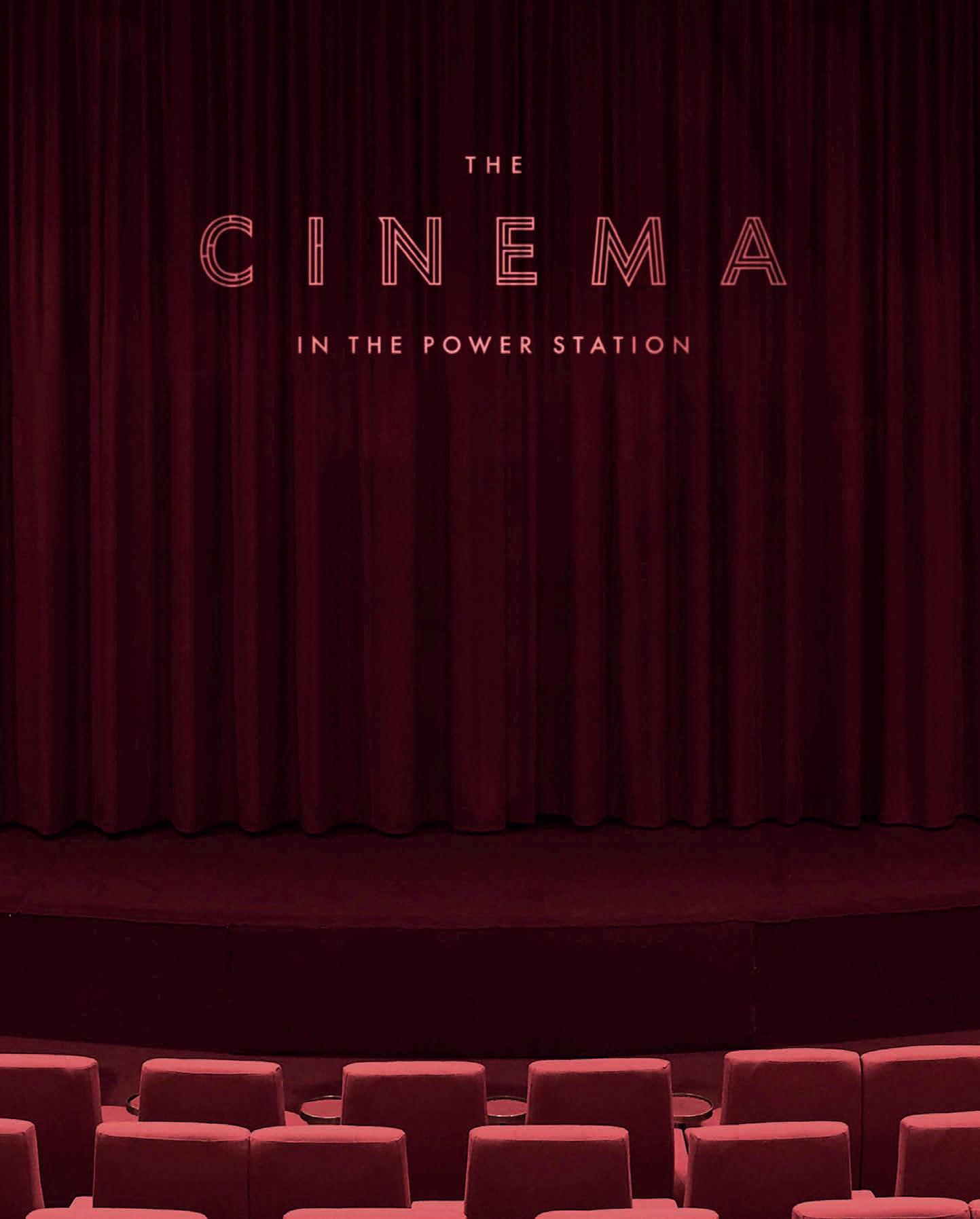
The Cinema In The Power Station is the quintessential location to enjoy the latest releases in an exquisite cinema with two screens, state-of-the-art Dolby Cinema and sumptuous reclining seating. With fine wines, champagnes, craft beers, home-made cocktails, popcorn, sweet and savoury treats all available to enjoy at your seat. www.thecinemainthepowerstation.com THE CINEMA IN THE POWER STATION 3rd Floor, Turbine Hall B, Battersea Power Station SW11 8DD LONDON’S MOST ICONIC CINEMA


110 SUBSCRIBE NOW TEMPUS ONLINE Get all the essential news and views from the world of luxury delivered direct to your door FOR YOUR DAILY DOSE OF THE BEST IN LUXURY NEWS, FEATURES AND EXCLUSIVE CONTENT Six copies of Tempus magazine delivered to your address every year Exclusive invitations to private events, from shoot days and polo matches to supper clubs and boutique showcases Access to exclusive digital content Regular newsletters featuring the latest news, reviews and exclusive member benefits Visit tempusmagazine.co.uk/subscribe tempusmagazine.co.uk

WINTER FORMAL
Tempus style columnist Rikesh Chauhan shares his picks for a fashionable festive season

This is the first year where everything seems more or less back to how it was before the Covid-19 pandemic began in 2020. Party invitations are coming in thick and fast, the temperature has finally dropped to the point where winter feels like, well, winter, and I’m staring wide-eyed at my wardrobe deciding what to wear for the upcoming event season.
One of the welcome changes from recent years is that the strict rules of formalwear are certainly easing. Long has Black Tie, White Tie and even Cocktail felt relatively fussy and boring. The pandemic heightened people’s need for comfort – and this didn’t just extend to the home, but to walks to the park, the office, eventually to weddings and now, finally, festive occasions. You’re always at your best when you’re comfortable and, when you’re comfortable, you tend to enjoy your surroundings much more. So when you’re in my position this festive season, where do you actually begin?
The dinner jacket is always going to be the focal point of any outfit and, fortunately, it’s a lot more versatile than you’d think. You have the option of keeping it simple or to go full on bells-and-whistles with a shawl collar smoking jacket with added frogging. Traditionally, this has most often been velvet with satin or grosgrain contrast facings, but you can now get jackets without this detail to give you more versatility. My preferred colours for dinner jackets are green, burgundy and, to a lesser extent, navy. They’re all a little more interesting than the classic black iterations and work tremendously well with a tonal colour — or black — bow tie.

Speaking of which, when it comes to bow ties (and general evening accessories) there’s really nowhere else one should look than La Bowtique. If you do have the option to get a bow tie from Mickael, I would highly suggest going bespoke. That being said, if you’re stuck on time and need something sooner than later, the
range of bow tie colours, fabrics and styles are vast enough to ensure you’ll definitely find something that ticks the box.
There are a variety of other things to consider when it comes to evening attire — the shirt and subsequent buttons, cufflinks and collar styles, waistcoats, trousers, pocket squares, watches and much more. However, I’ve decided to focus on the footwear, just because the slipper is simply so much fun. As with the bow ties, there’s one brand that immediately comes to mind: Stubbs & Wootton. Such is the variety of styles available that you can really let your character and flair shine here, whether you go for the classic negroni emblem or skull and crossbones, a classic plain finish in leather, straw or needlepoint, and in colours ranging from black velvet to as bold as you can imagine. I’ve highlighted their Crest slipper, because it is spectacular in colour, comfort and design. What more could one want for the holiday season?
Single-breasted, single-buttoned velvety goodness from New & Lingwood will keep you looking elegant all night.
newandlingwood.com
While black satin can work equally well, a bow tie that matches your velvet jacket will always be a stellar go-to. labowtique.com

A spectacular, stand out design with a needlepoint upper and lined in leather. The slipper of all slippers this season.
stubbsandwootton.com

112
COLUMN
PORTRAIT: © HANNAH MILES
Green Peak Lapel Velvet Evening Jacket by New & Lingwood
Emerald Green Velvet Medium Bow Tie by La Bowtique
Crest Slippers by Stubbs & Wootton



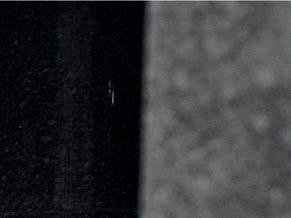





























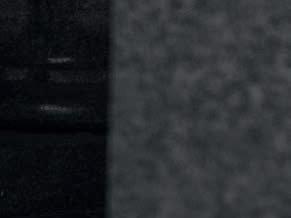







113
GREAT BRITISH LUXURY CLOTHING | PRIVATEWHITEVC.COM

#TIMEISFLYING




 * Piper-Heidsieck Chief winemaker was acknowledged as best of the year nine times since 2000 by the IWC.
* Piper-Heidsieck Chief winemaker was acknowledged as best of the year nine times since 2000 by the IWC.






































































 la-colombe-dor.com
la-colombe-dor.com


















 Words: Rory FH Smith
Words: Rory FH Smith













 Words: Michelle Johnson • Translation: Claudia Dickson • Coordinated by: Peter Malmstrom
Words: Michelle Johnson • Translation: Claudia Dickson • Coordinated by: Peter Malmstrom























 Words: Judy Cogan
Words: Judy Cogan
































































 Luxury unlocked: The Bulgari Villa (below),; villa and spa interiors (left)
Luxury unlocked: The Bulgari Villa (below),; villa and spa interiors (left)
 Words: Rory FH Smith
Words: Rory FH Smith






 Words: Michelle Johnson
Words: Michelle Johnson





























































































